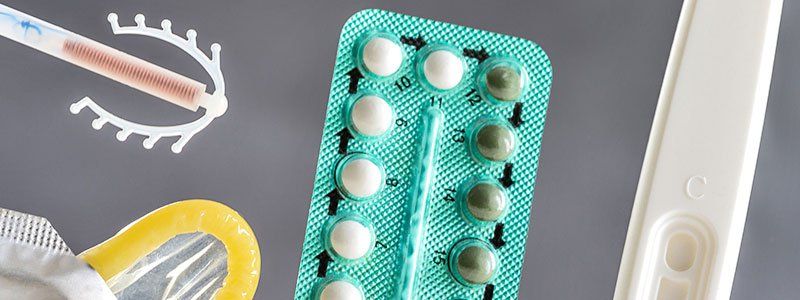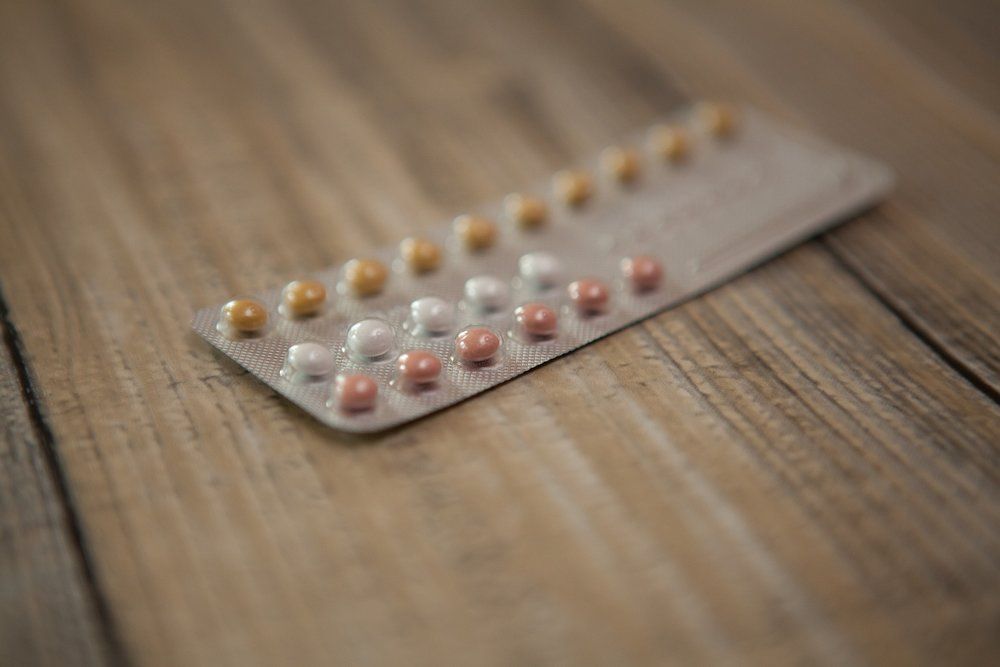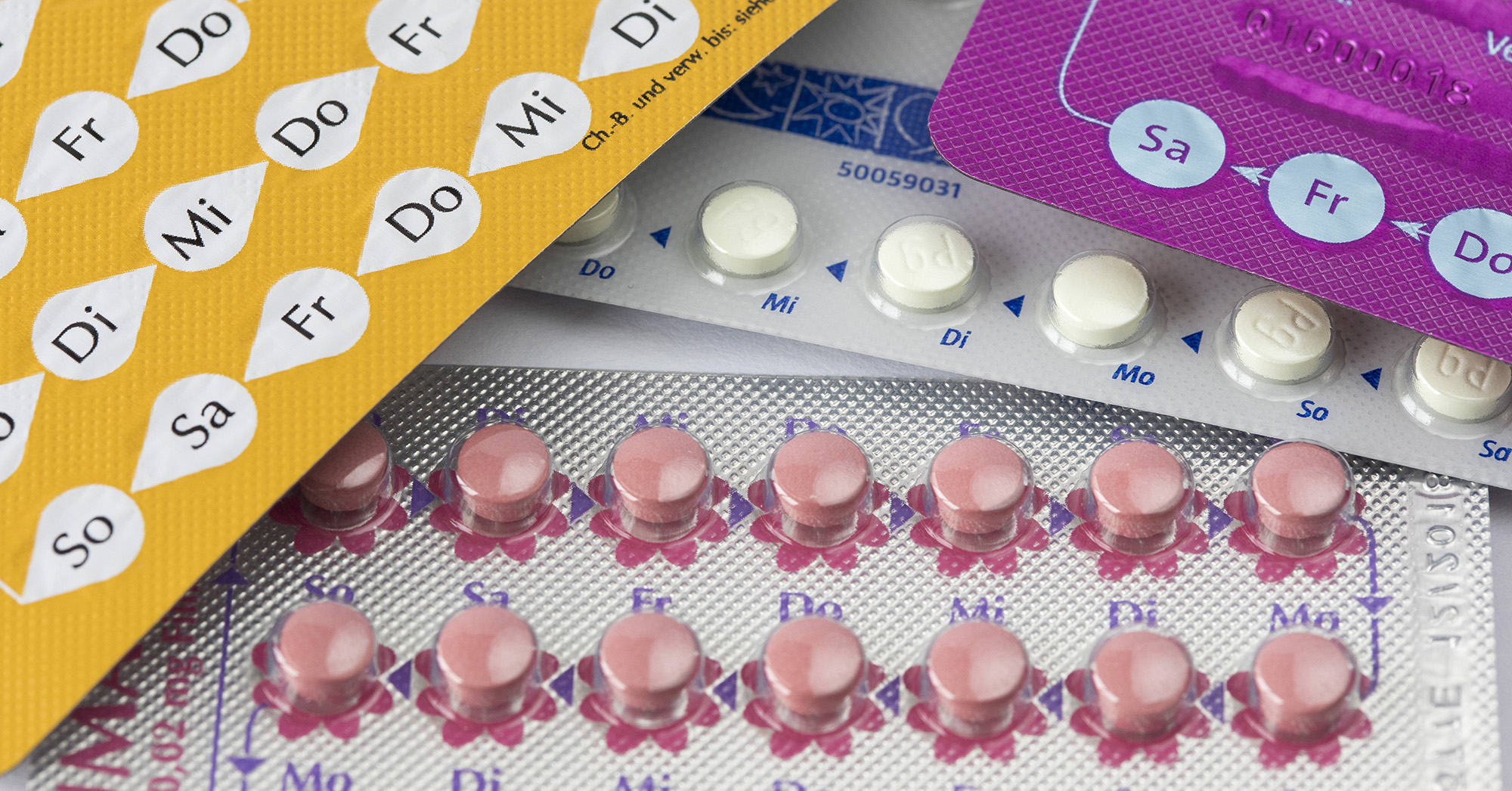Methods of birth control and side effects. Birth Control Options & Types: Risks & Effectiveness
What are the different types of birth control methods? How effective are they? What are the potential side effects? Get the facts about birth control options and choose the right method for you.
Exploring Birth Control Options
Birth control is a crucial aspect of family planning and reproductive health. There are numerous methods available, each with its own unique characteristics, advantages, and drawbacks. By understanding the various birth control options, individuals can make informed decisions that align with their personal preferences, lifestyle, and health needs.
Abstinence: The Foolproof Method
Abstinence, or refraining from sexual intercourse, is the only birth control method that is 100% effective in preventing pregnancy. It is also the best way to protect against sexually transmitted diseases (STDs). However, it requires a strong commitment and discipline, as well as open communication and understanding between partners.

Surgical Sterilization: Permanent Solutions
Surgical sterilization methods, such as tubal ligation for women and vasectomy for men, offer a permanent solution to prevent pregnancy. Tubal ligation involves surgically closing or blocking the fallopian tubes, while vasectomy involves cutting and sealing the vas deferens, the tubes that carry sperm. These procedures are highly effective, with failure rates of less than 1%.
Tubal Ligation
Tubal ligation is a surgical procedure performed under anesthesia, where the fallopian tubes are blocked or sealed. It is a permanent form of birth control and is almost 100% effective, with a failure rate of about 3-17 per 1,000 procedures.
Vasectomy
Vasectomy is a simple, outpatient procedure that involves cutting and sealing the vas deferens, the tubes that carry sperm. It is a highly effective and permanent method of male sterilization, with a failure rate of less than 1%.
Hormonal Contraceptives: Versatile Options
Hormonal birth control methods work by regulating the menstrual cycle and preventing ovulation. These options include oral contraceptives (the “pill”), patches, rings, implants, and injections. They are highly effective, with failure rates ranging from less than 1% to 9% with typical use.
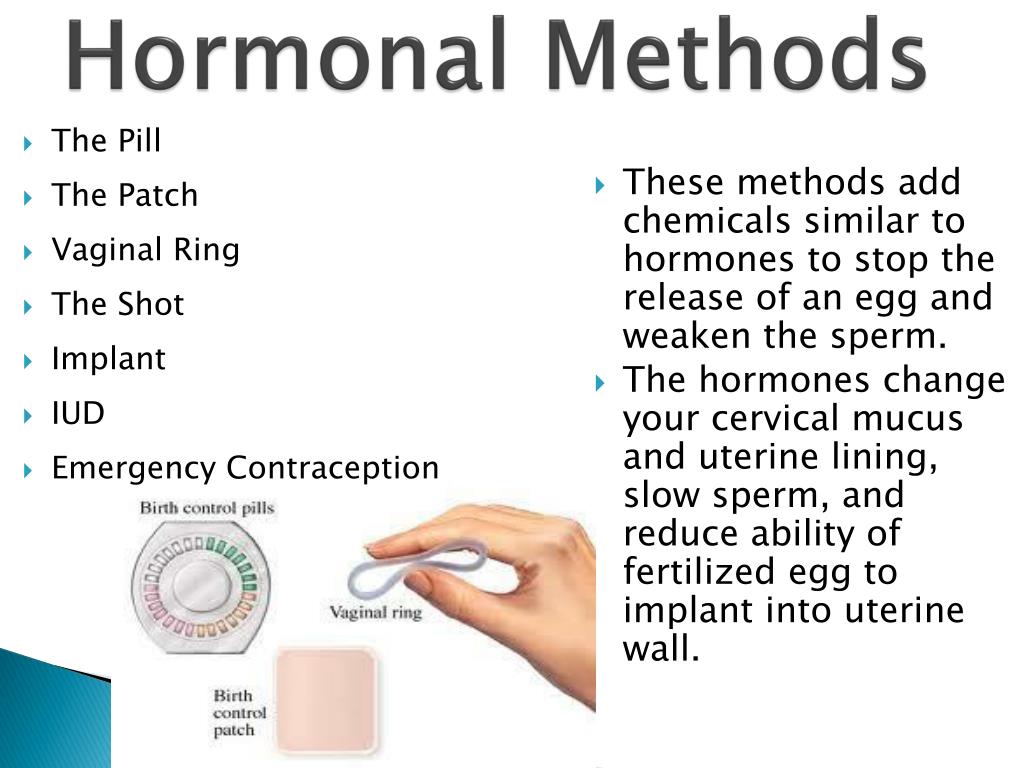
Nexplanon Implant
Nexplanon is a single rod-shaped implant that is inserted under the skin of the upper arm. It delivers a continuous dose of the progestin hormone over a three-year period and is almost 100% effective in preventing pregnancy.
Barrier Methods: Physical Protection
Barrier methods, such as condoms and diaphragms, physically prevent sperm from entering the uterus. They are generally less effective than hormonal or surgical methods, with failure rates ranging from 2% to 20% with typical use.
Male Condoms
Male condoms are a popular and widely available barrier method that can protect against both pregnancy and sexually transmitted infections. When used correctly, condoms have a failure rate of about 2% to 18% with typical use.
Female Condoms
Female condoms are an alternative barrier method that can be inserted into the vagina before intercourse. They have a slightly higher failure rate than male condoms, ranging from 5% to 21% with typical use.
Natural Methods: Fertility Awareness
Natural birth control methods, such as the rhythm method, withdrawal, and fertility awareness-based methods, rely on monitoring the menstrual cycle and avoiding intercourse during the fertile window. These methods are generally less effective, with failure rates ranging from 2% to 24% with typical use.
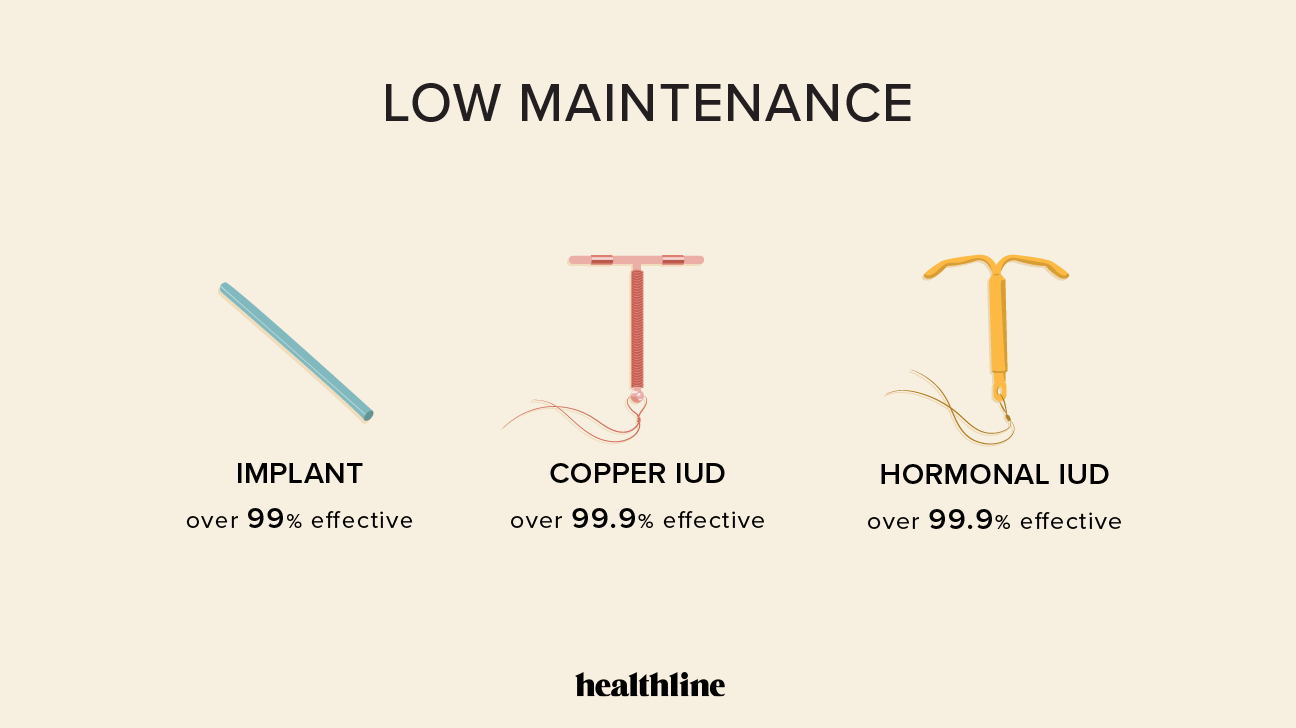
Rhythm Method
The rhythm method, also known as the calendar method, involves tracking the menstrual cycle and abstaining from intercourse during the fertile days. It has a failure rate of around 2% to 24% with typical use.
Withdrawal (Pulling Out)
Withdrawal, or the “pull-out” method, involves the male partner removing his penis from the vagina before ejaculation. It has a failure rate of around 4% to 22% with typical use.
Selecting the Right Birth Control Method
When choosing a birth control method, it’s important to consider factors such as effectiveness, convenience, cost, and potential side effects. It’s also crucial to discuss your options with a healthcare provider, who can help you weigh the pros and cons and select the most suitable method for your individual needs and preferences.
Regardless of the birth control method chosen, it’s essential to use it consistently and correctly to maximize its effectiveness. Regular communication with a healthcare provider, as well as open and honest discussions with your partner, can help ensure that the chosen birth control method is both effective and aligned with your overall reproductive health goals.

Birth Control Options & Types: Risks & Effectiveness
What is birth control?
Birth control is a way for men and women to prevent pregnancy. There are many different methods of birth control. By learning more about the options, you can decide which method is right for you and your partner.
If you are sexually active and don’t want a baby, don’t wait to use birth control. An unintended pregnancy can happen any time you have unprotected sex.
What are the types of birth control?
The following information describes many different birth control methods. Before you choose a method, you should discuss birth control with your partner and your healthcare provider.
Birth control methods are only effective if used properly. Make sure that you understand how to correctly use the method you choose.
Abstinence
Abstinence is the only birth control that is 100 percent effective and is also the best way to protect you against STDs. You may not be ready to have sex. Don’t let someone pressure you into having sex if you don’t feel ready. It is an important decision with serious emotional and physical consequences.
Don’t let someone pressure you into having sex if you don’t feel ready. It is an important decision with serious emotional and physical consequences.
Female sterilization – tubal ligation (surgical)
What is it? Tubal ligation is surgery to “tie the tubes” (fallopian tubes) of a woman. This causes permanent sterility by preventing transport of the egg (ovum) to the uterus. This also blocks the passage of sperm up the tube to the ovulating ovary where fertilization normally occurs.
How is it done? Tubal ligation is done in a hospital or outpatient surgical clinic while the patient is asleep (given anesthesia). One or two small incisions (cuts) are made in the abdomen at the navel, and a device similar to a small telescope on a flexible tube (called a laparoscope) is inserted. Using instruments that are inserted through the laparoscope, the fallopian tubes are burned or sealed shut. The skin incision is then stitched closed. Tubal ligation can be performed immediately after childbirth through a small incision near the navel or during a Cesarean section (C-section).
How is it available? Tubal ligation must be performed by a healthcare provider.
How effective is it? Except in rare cases, this procedure is almost 100 percent effective. Depending on the technique your doctor uses, tubal ligation has about three to 17 failures in 1,000 procedures.
You should know: Female sterilization is not reversible. Sterilization does not protect against STDs, including HIV (the virus that causes AIDS). The male condom provides the best protection against most STDs.
Male sterilization – Vasectomy
What is it? A vasectomy is a simple, permanent sterilization procedure for men. The operation, usually done in a physician’s office, requires cutting and sealing the vas deferens, the tubes in the male reproductive system that carry sperm. A vasectomy prevents the transport of sperm out of the testes. This surgery does not affect the man’s ability to achieve orgasm or ejaculate (potency). There will still be a fluid ejaculate, but there will be no sperm in this fluid. Studies have shown that vasectomy increases sexual satisfaction between couples.
There will still be a fluid ejaculate, but there will be no sperm in this fluid. Studies have shown that vasectomy increases sexual satisfaction between couples.
How is it done? Vasectomy is usually done in the surgeon’s office while the patient is awake but pain-free (using local anesthesia). A small incision is made in the upper part of the scrotum. The tubes (vas deferens) are tied off and cut apart. The skin incision is stitched closed. The patient is able to return home immediately. Vasectomy is a much simpler procedure than tubal ligation.
How is it available? Vasectomy must be performed by a healthcare provider.
How effective is it? Except in rare cases, this procedure is nearly 100 percent effective. Although vasectomy has a failure rate of less than 1 percent, failure, while rare, is possible.
You should know: Sterilization does not protect against STDs, including HIV (the virus that causes AIDS). The male condom provides the best protection against most STDs.
The male condom provides the best protection against most STDs.
Progestin arm implant – Nexplanon®
What is it? Nexplanon® is a single rod of hormone (the size of a matchstick) that is placed directly under the skin of the upper arm by a physician. It delivers a progestin hormone (no estrogen), over a three-year period.
How can I get it? Nexplanon® is placed by a physician who is certified in this procedure.
How effective is it? Nexplanon® is almost 100 percent effective. It is the most effective form of reversible contraception, with less chance of failure than even female sterilization.
You should know: The side effects of Nexplanon® are similar to other progestin-only (no estrogen) methods. The most common side effect is irregular bleeding, though the bleeding tends to be light. This typically improves after six to 12 months, with many women having no further bleeding (which is safe).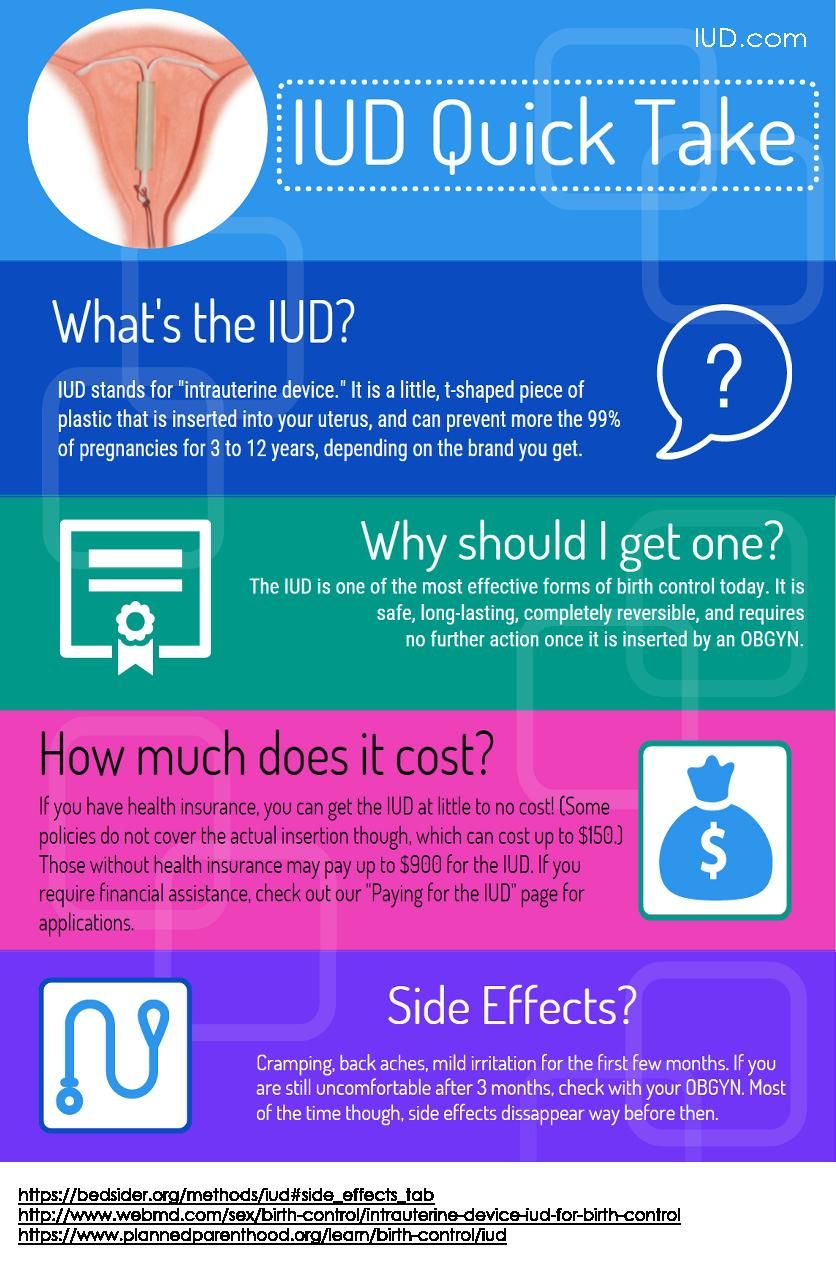 Nexplanon® will need to be removed via an office procedure after three years, but can removed at any time before that time if desired.
Nexplanon® will need to be removed via an office procedure after three years, but can removed at any time before that time if desired.
Intrauterine device (IUD)
What is it? An intrauterine device (IUD) is a small, flexible, T-shaped device that is placed into the uterus (womb). There two types of IUDs:
- An IUD made of copper
- An IUD made of plastic with very low doses of progestin (no estrogen)
The copper ParaGard T380A®, can be kept in place for 10 years. The copper stops the sperm from making it through the vagina and uterus to reach the egg, preventing fertilization.
The progestin IUDs include Mirena® (five years, highest progestin dose), Kyleena® (five years, medium dose), and Skyla® (three years, lowest progestin dose). The progestin dose of the IUDs are so low, that they have minimal absorption into the body. These IUDs work by causing the cervical mucus to become thicker so the sperm cannot reach the egg. The hormone also thins the lining of the uterus, so menstrual bleeding becomes lighter.
How is it used? Once the IUD has been inserted, the woman does not need to take any further steps to prevent pregnancy.
How is it available? After a pelvic exam, the IUD is placed into the uterus through the cervix by a trained healthcare provider.
How effective is it? The IUD is close to 100 percent effective. Progestin containing IUDs and the arm implant are the most effective contraceptive options.
You should know: Side effects are different for the different IUDs. Copper IUDs may cause more painful and heavy periods in some women. The advantage is that it can be used in women who can’t use any hormones (such as breast cancer survivors). The side effects of progestin containing IUDs are similar to other progestin-only (no estrogen) methods. The most common side effect is irregular bleeding, though the bleeding tends to be light. This typically improves after six to 12 months, with many women having no further bleeding (which is safe).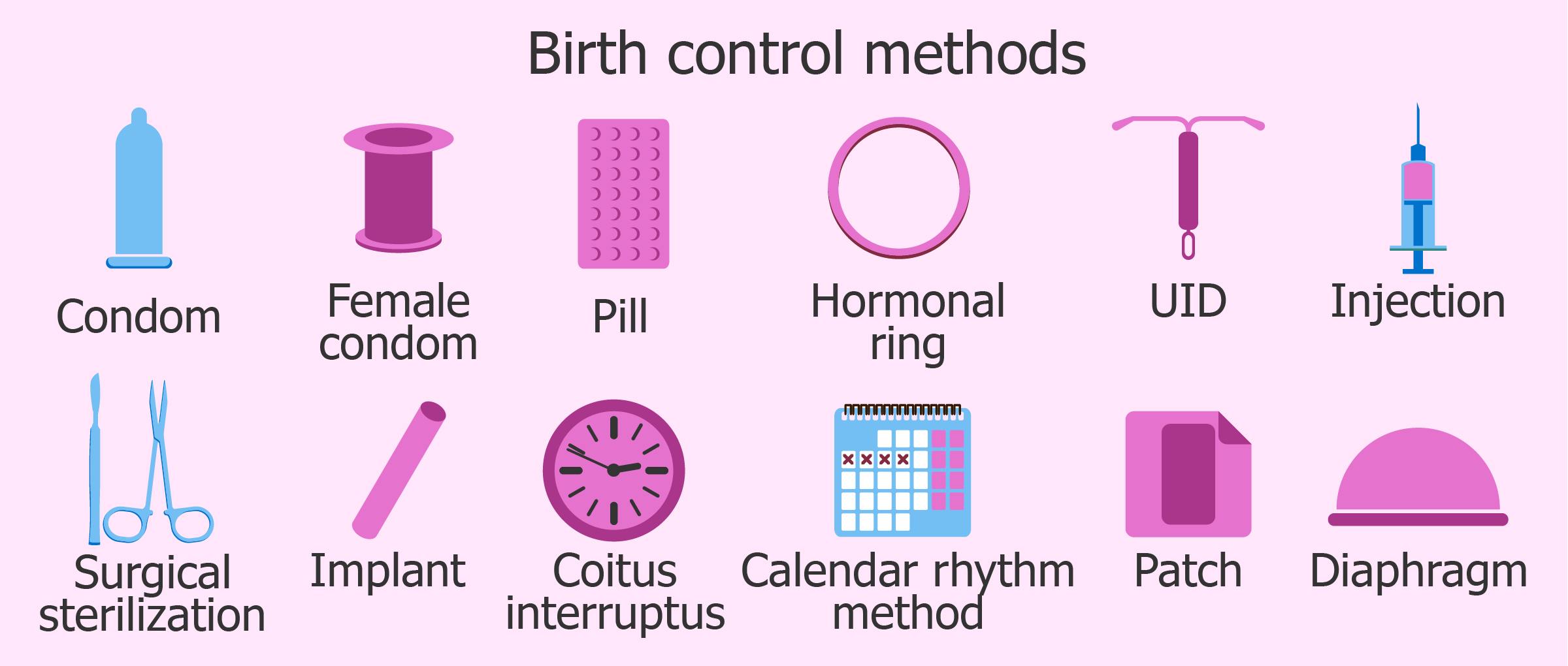 IUDs will need to be removed via a simple office procedure at the expiration time, but can removed at any time before that time if desired. In the rare chance pregnancy occurs while having an IUD, there is greater risk of ectopic pregnancy (pregnancy outside the uterus).
IUDs will need to be removed via a simple office procedure at the expiration time, but can removed at any time before that time if desired. In the rare chance pregnancy occurs while having an IUD, there is greater risk of ectopic pregnancy (pregnancy outside the uterus).
Combined hormonal contraception
Includes estrogen containing birth control pills, the contraceptive vaginal ring (NuvaRing®), and patch (Xulane®)
What is it? The pill, patch and ring are medications that women take to prevent pregnancy. The pill is taken daily, the vaginal ring is used once a month, and the patch is changed weekly.
How is it used? A pill is taken at the same time every day. There are several different types of pills. Some are designed to allow the woman to have a period every month and others allow the women to have period every three months or not at all.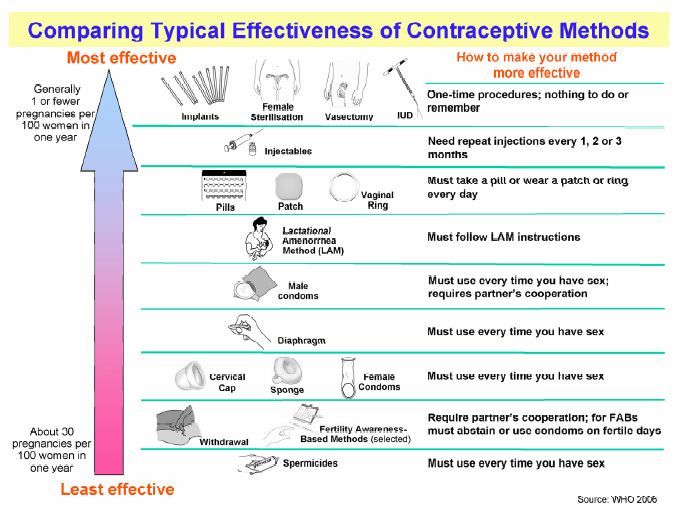 All of these methods require that a woman use it regularly. If you forget to use the contraceptive, irregular menstrual cycles are common, and you can get pregnant.
All of these methods require that a woman use it regularly. If you forget to use the contraceptive, irregular menstrual cycles are common, and you can get pregnant.
How can I get it? In most states, the pill must be ordered for you by your healthcare provider. It is obtained by prescription. In a growing number of states it is available over-the-counter without a prescription, under the supervision of a pharmacist.
How effective is it? Combined hormonal contraceptives have the potential to be 99 percent effective if used correctly. However, in the real world with typical use, nine out of 100 women will get pregnant each year on the pill because they do not use it correctly. Some studies show that women who are overweight might be more likely to get pregnant while on the pill than normal weight women. However, the pill is much more effective than the barrier methods such as condoms, diaphragm, cervical cap, contraceptive foam, etc.
You should know: The pill can cause minor side effects in the first several months of use, including:
- Breast tenderness/pain
- Nausea
- Headaches
- Irregular menses
Typically these symptoms resolve.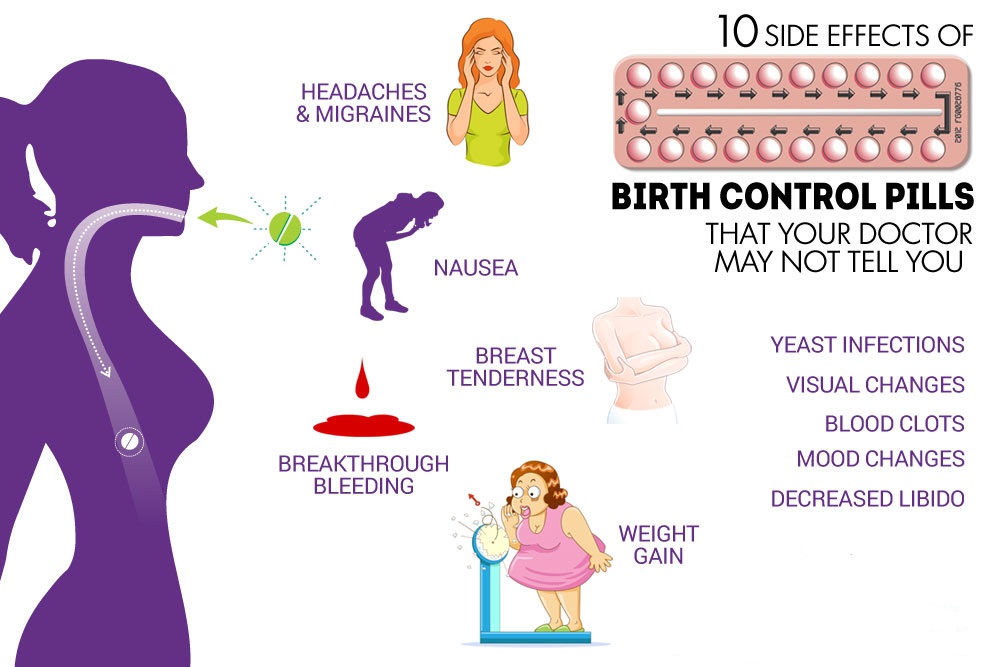 Estrogen containing contraceptives can increase the risk of blood clots. Estrogen containing contraceptives are not recommended for women who are over 35 years of age if they smoke, but can be used until menopause if you don’t smoke cigarettes and are in good health. There are many health benefits to these contraceptives, including lighter, regular periods, as well as less menstrual cramping. Pill users also will notice improvement in acne, PMS, menstrual headaches, as well as a lower risk of uterine and ovarian cancer in pill users.
Estrogen containing contraceptives can increase the risk of blood clots. Estrogen containing contraceptives are not recommended for women who are over 35 years of age if they smoke, but can be used until menopause if you don’t smoke cigarettes and are in good health. There are many health benefits to these contraceptives, including lighter, regular periods, as well as less menstrual cramping. Pill users also will notice improvement in acne, PMS, menstrual headaches, as well as a lower risk of uterine and ovarian cancer in pill users.
Progestin only pills (mini pills)
What is it? These are pills that contain only one hormone (progestin).
How do they work? Mini pills work by thickening the cervical mucus so the sperm cannot reach the egg. The hormone in the pills also thins the lining of the uterus, so menstrual bleeding is lightened. A pill is taken every day with no placebo (break).
How is it available? In most states, the pill must be ordered for you by your healthcare provider.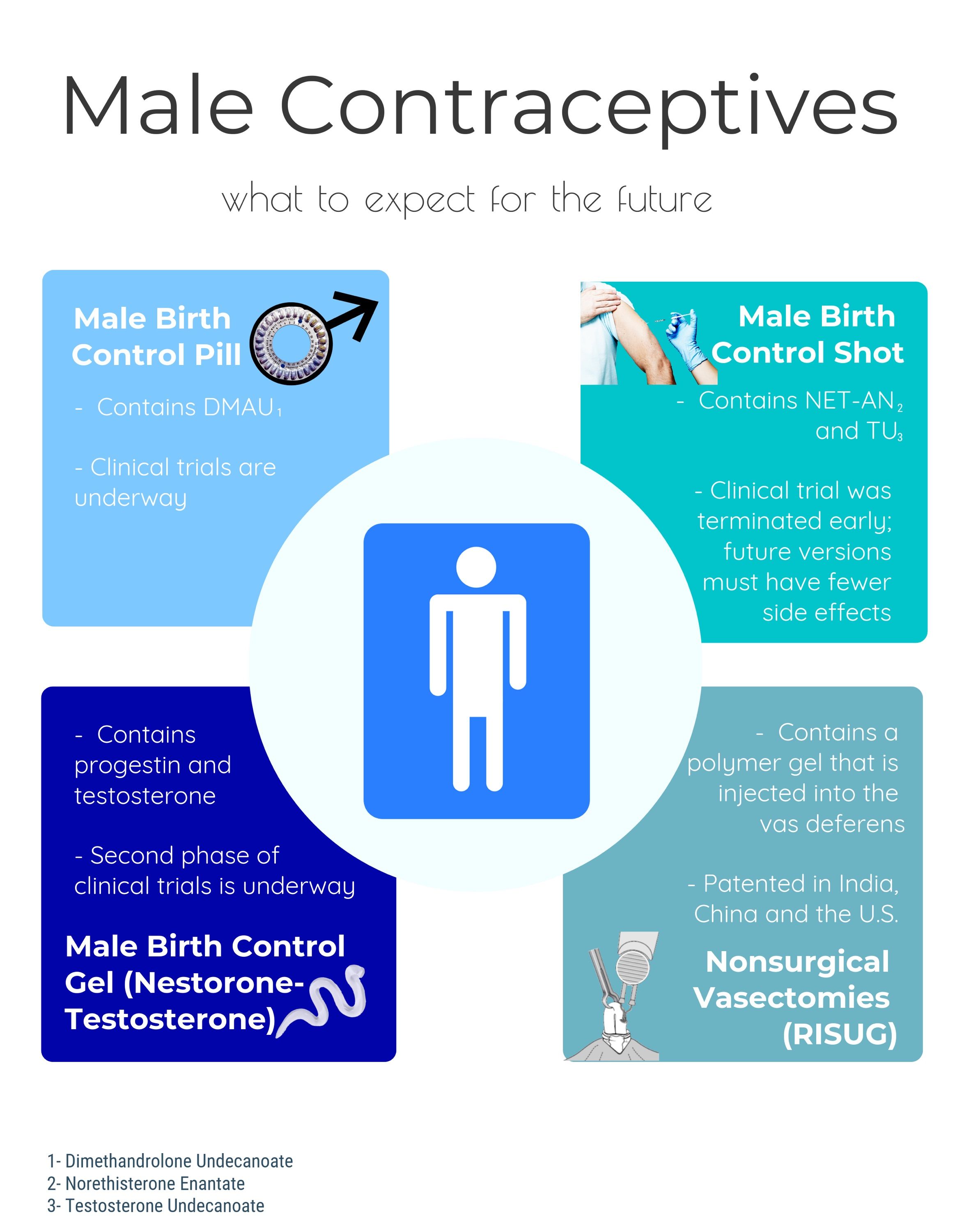 It is obtained by prescription. In a growing number of states it is available over-the-counter without a prescription, under the supervision of a pharmacist.
It is obtained by prescription. In a growing number of states it is available over-the-counter without a prescription, under the supervision of a pharmacist.
How effective is it? With typical use, nine out of 100 women will get pregnant each year on the pill because they do not use it correctly. It is important to take it daily, at the same time each day. Some studies show that women who are overweight might be more likely to get pregnant while on the pill than thinner women. However, the pill is much more effective than the barrier methods such as condoms, diaphragm, cervical cap, contraceptive foam, etc.
You should know: The side effects of progestin only pills are similar to other progestin-only (no estrogen) methods. The most common side effect is irregular bleeding, though the bleeding tends to be light. This typically improves after six to 12 months, with many women having no further bleeding (which is safe). The mini pill is a good alternative for women who are breastfeeding or who cannot take estrogen in the traditional pill.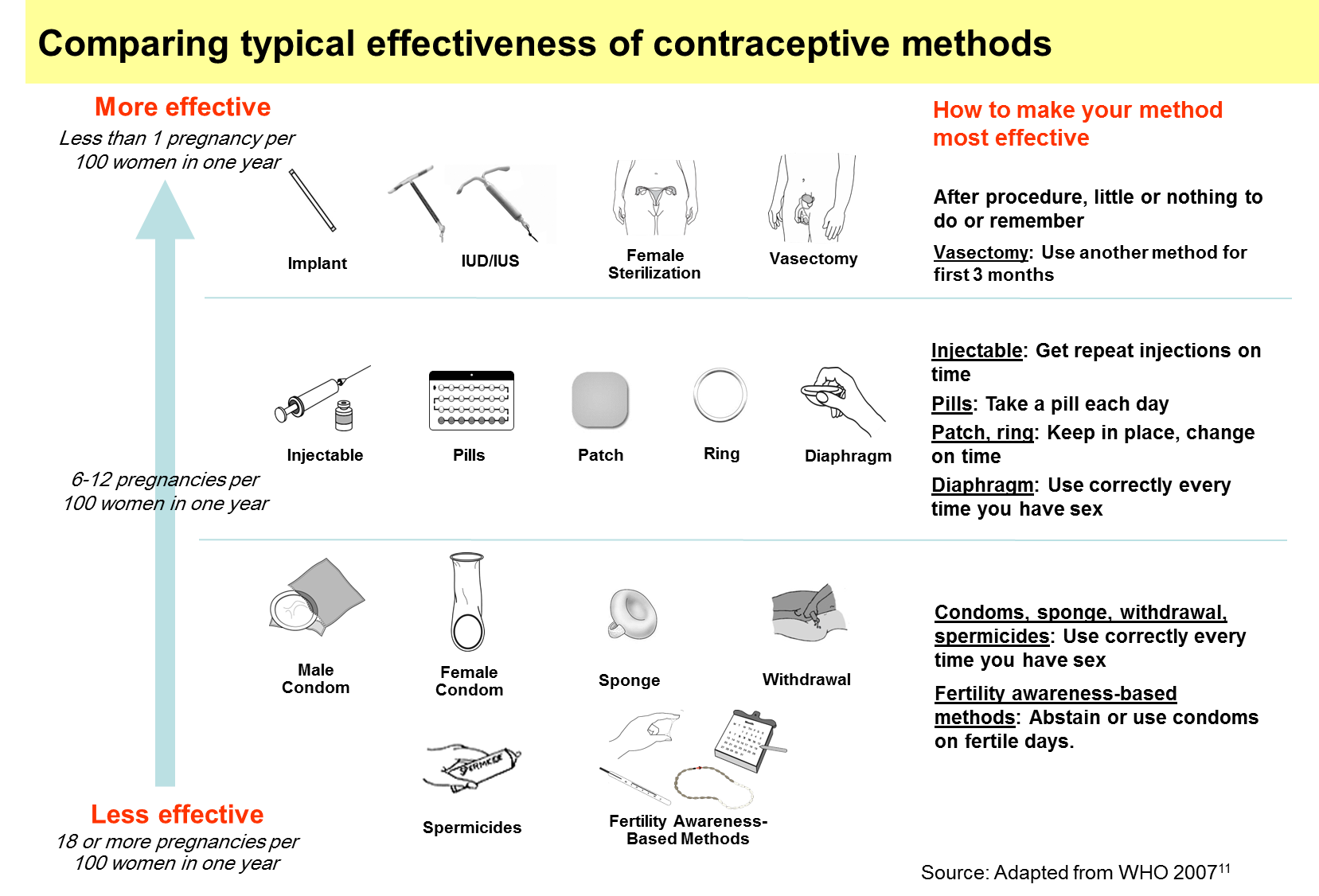
Depo-provera®
What is it? Depo-Provera® is a form of the hormone progestin.
How is it used? It is given as an injection into the woman’s buttocks or arm. Each injection provides protection against pregnancy for 12 to 15 weeks.
How is it available? Depo-Provera® must be ordered by a healthcare provider. It is taken every three months, usually given at the doctor’s office. There is a lower dose formulation that is available to be injected at home by the patient.
How effective is it? The Depo-Provera® shot has the potential to be 99 percent effective if used correctly. However, with typical use, six out of 100 women will get pregnant each year on the shot because they do not get the four injections per year on time.
You should know: Depo-Provera®’s bleeding profile is similar to other progestin-only (no estrogen) methods. Fifty percent of women who use Depo-Provera for more than a year stop getting their periods while on the medication.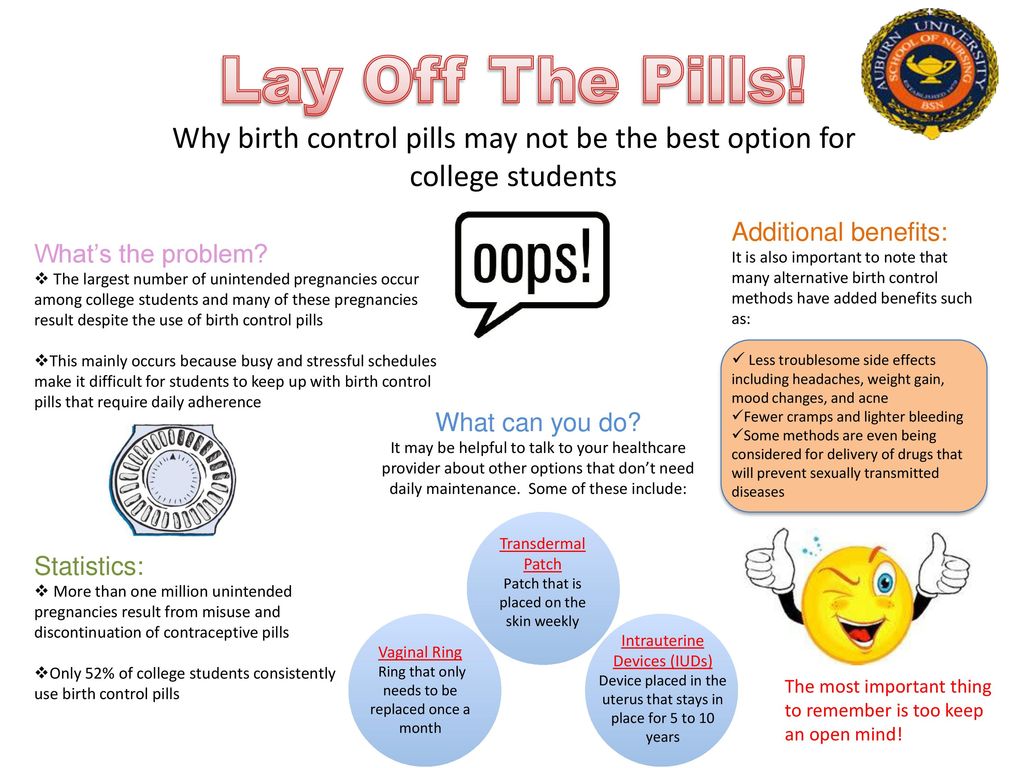 However, some irregular bleeding can occur, especially in the first year. In a small percentage of women, Depo-Provera can cause some weight gain. This is the only contraceptive that may do this. However, most women on Depo-Provera® do not gain any weight. A healthy lifestyle can prevent chance of weight gain.
However, some irregular bleeding can occur, especially in the first year. In a small percentage of women, Depo-Provera can cause some weight gain. This is the only contraceptive that may do this. However, most women on Depo-Provera® do not gain any weight. A healthy lifestyle can prevent chance of weight gain.
Emergency contraception (or “morning after pill”)
What is it? Emergency contraception is a form of birth control that may be used by women within 120 hours (five days) of having unprotected sex. This may be necessary in the case of contraceptive failure (broken condom), rape, or any other situation where highly effective contraception was not available. It is most effective when taken soon after unprotected intercourse. A copper IUD is the most effective form of emergency contraception, and also provides ongoing birth control. There are two types of emergency contraceptive pills available. The more effective pill is called ulipristal (brand name: ella).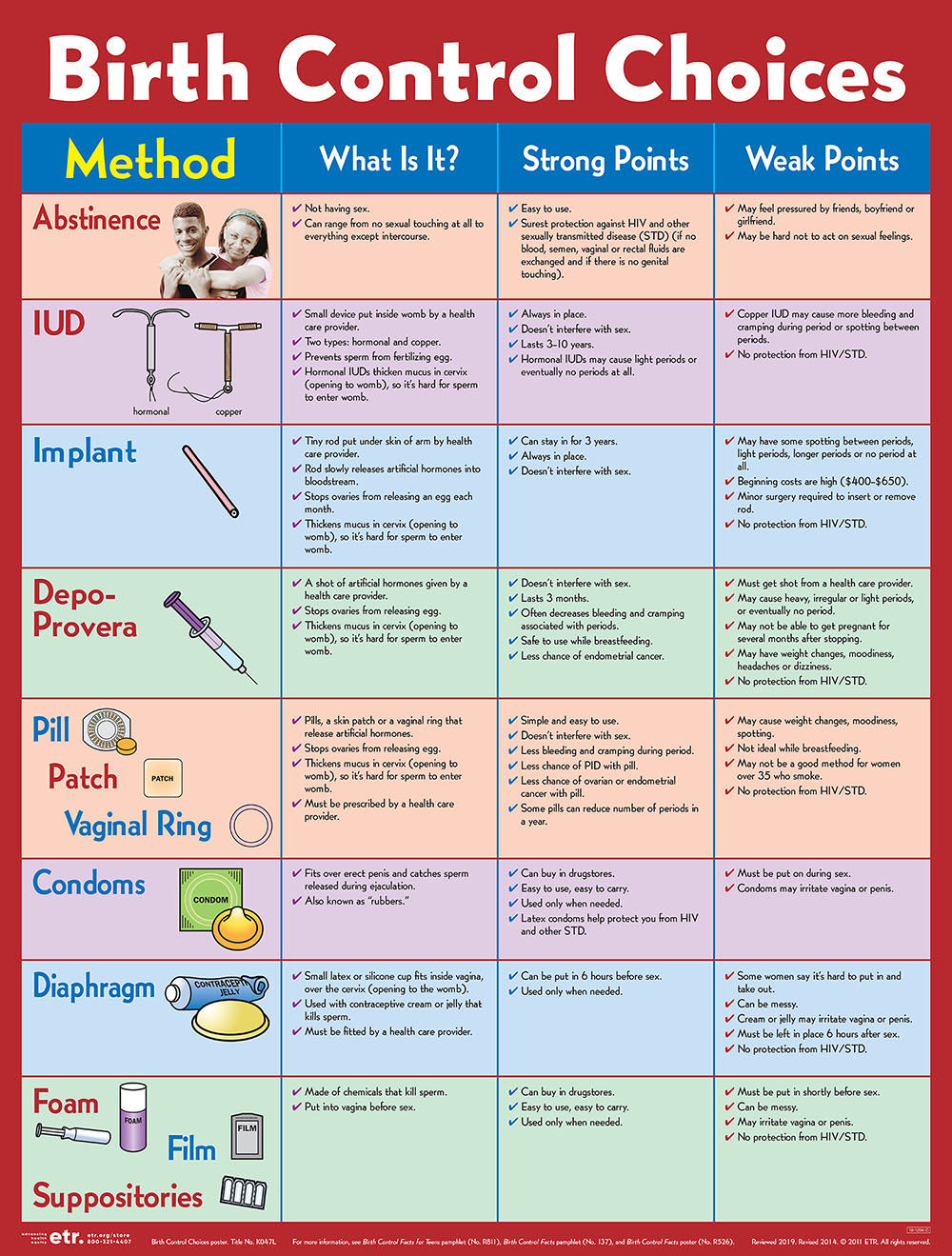 It is only available by prescription. Several over-the-counter options are available and all contain levonorgestrel (many generic names including Plan B, Next Choice, etc).
It is only available by prescription. Several over-the-counter options are available and all contain levonorgestrel (many generic names including Plan B, Next Choice, etc).
How does it work? The pills prevent pregnancy by temporarily blocking eggs from being produced (delaying ovulation). The copper IUD makes it difficult for sperm to get to the egg.
How is it available? Over-the-counter levonorgestrel pills can be purchased at a pharmacy without a prescription by men and women of any age (including those under age 16). Ulipristal (ella) has to be prescribed by a provider. Because many pharmacies will need to order ella (delaying when you’ll receive it), consider asking your doctor for an advanced prescription to have on hand in case of emergency. An IUD requires an office visit for procedure within five days of intercourse.
How effective is it? Emergency contraceptive pills can be up to 90 percent effective when taken within 72 hours of unprotected intercourse.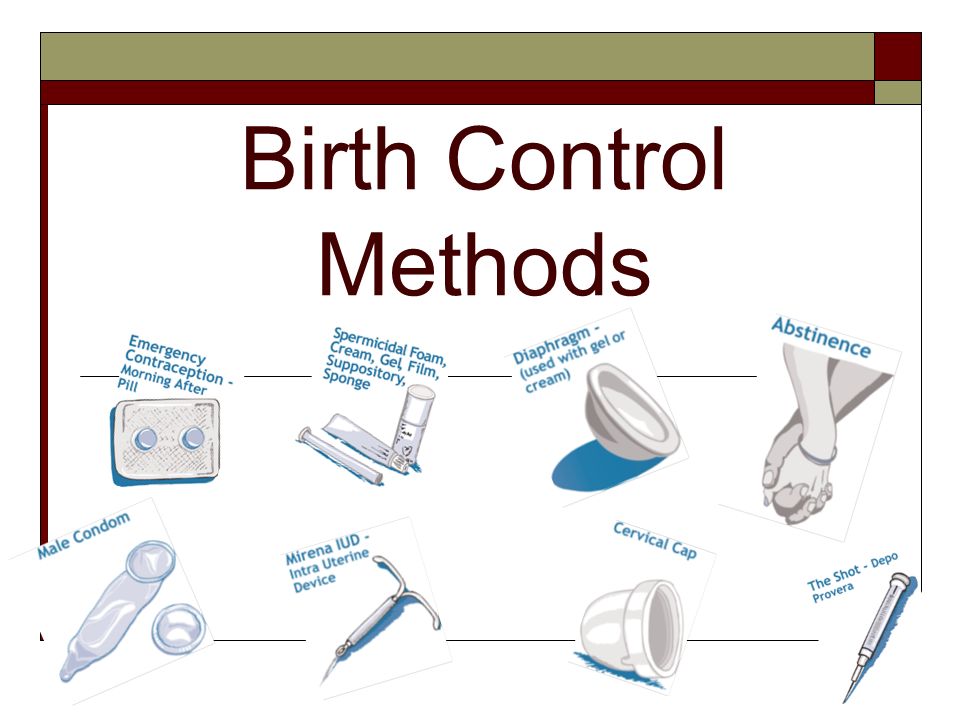 However, no pills will work if you have already ovulated. This is why it’s important to take it as soon as possible after intercourse. Ella is two times more effective than the over-the-counter pills. A copper IUD is almost 100 percent effective.
However, no pills will work if you have already ovulated. This is why it’s important to take it as soon as possible after intercourse. Ella is two times more effective than the over-the-counter pills. A copper IUD is almost 100 percent effective.
You should know: You do not need to take a pregnancy test before taking emergency contraception pills. Menstrual irregularities are common for the few weeks after the pills have been taken. However, if you do not get your menstrual cycle within a few weeks of taking emergency contraception, you should take a pregnancy test since these methods are not 100 percent effective. It is important to use condoms or abstain from intercourse for the next five days after taking emergency contraception, otherwise you can get pregnant. If you find yourself taking emergency contraceptive pills frequently, speak to your doctor about more effective ways to prevent pregnancy.
Male condoms
What is it? The male condom, or “rubber,” is a thin covering made of latex, plastic or animal membrane that is rolled over an erect penis.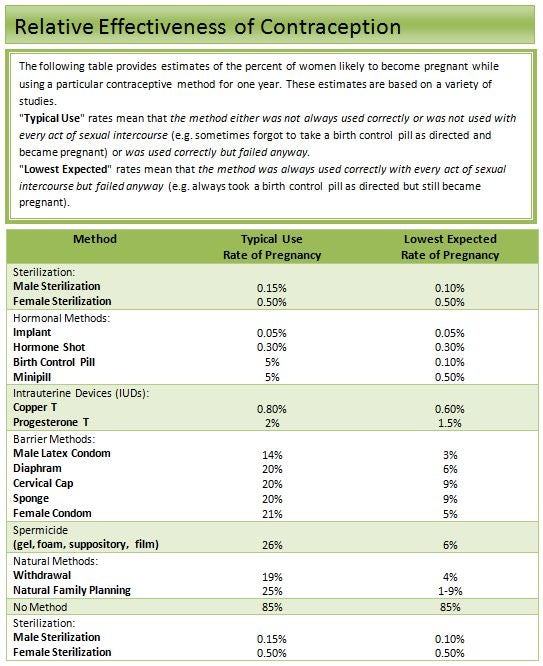 The covering prevents semen, the fluid that contains sperm, from entering a woman’s vagina. Latex condoms are best for most people. Use plastic condoms if you or your partner is allergic to latex. Condoms made from animal skins may not provide good protection from sexually transmitted diseases (STDs).
The covering prevents semen, the fluid that contains sperm, from entering a woman’s vagina. Latex condoms are best for most people. Use plastic condoms if you or your partner is allergic to latex. Condoms made from animal skins may not provide good protection from sexually transmitted diseases (STDs).
How is it used? The condom is rolled over the erect penis before sexual activity begins. If the condom does not have a built-in nipple, leave ¼-inch of the condom free at the tip of the penis so that semen has a place to collect. A new condom must be used each time you have sex. The condom must be in place before the penis gets near the vagina.
How can I get it? Condoms can be purchased at most drug stores. Condoms also are sold in vending machines in restrooms.
How effective is it? About 18 percent of women will get pregnant each year when condoms are used. However, condoms can be more effective when they are used exactly as intended.
You should know: Latex condoms provide protection—although not 100 percent protection—from STDs by preventing the infected area from coming into contact with the partner. Even though they do not provide 100 percent protection, they are one of the best options available. Use only water-based lubricants, such as K-Y Jelly® or Astroglide®. Oil-based lubricants (Vaseline®, baby oil) can cause condoms to leak or break. If a condom breaks, a woman is at increased risk of getting pregnant. She should consider emergency contraception.
Diaphragm
What is it? A diaphragm is a round piece of flexible rubber with a rigid rim. The woman places the diaphragm in her vagina and against her cervix. The diaphragm prevents semen from entering the womb. Spermicide must be used with a diaphragm.
How is it used? Spermicide is put in and around the rim of the diaphragm no more than two hours before intercourse. The diaphragm is then inserted into the vagina. More spermicide should be inserted into the vagina each time you have sex without removing the diaphragm.
More spermicide should be inserted into the vagina each time you have sex without removing the diaphragm.
How can I get it? You must visit your healthcare provider and get a pelvic exam so that you can be fitted for a diaphragm that is right for you. There is one diaphragm that is “one-size-fits-all,” called Caya, which can be purchased online.
How effective is it? About 12 percent of women get pregnant each year despite using a diaphragm, but it can be more effective when used exactly as instructed.
You should know: Do not remove the diaphragm for at least eight hours after intercourse. Using a diaphragm and spermicide may not protect against some STDs, including HIV (the virus that causes AIDS). The male condom provides the best protection against most STDs. If you gain or lose 10 to 15 pounds, you may have to be refitted for a new diaphragm.
Cervical cap
What is it? The cervical cap is a thimble-shaped cup made out of plastic or soft rubber that fits snugly over the cervix.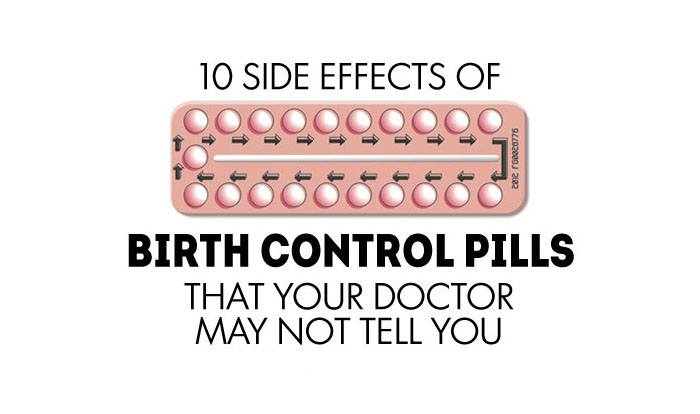
How is it used? It is used the same way as a diaphragm. The woman coats the cup with spermicide, and inserts the cap into her vagina and up to her cervix before sex. The cap blocks the cervix, and the spermicide paralyzes the sperm. More spermicide must be inserted into the vagina each time you have sex. (Do not remove the cap each time you have sex.)
How can I get it? You must visit your healthcare provider and get a pelvic exam so that you can be fitted for a cervical cap.
How effective is it? About 21 percent of women get pregnant each year despite using a cervical cap, but it can be more effective when used exactly as instructed.
You should know: Do not remove the cervical cap for at least eight hours after intercourse. The cap can be kept in place for up to 48 hours, but spermicide must be applied inside the vagina no more than two hours before sex. Using a cervical cap and spermicide may not protect against some STDs, including HIV (the virus that causes AIDS).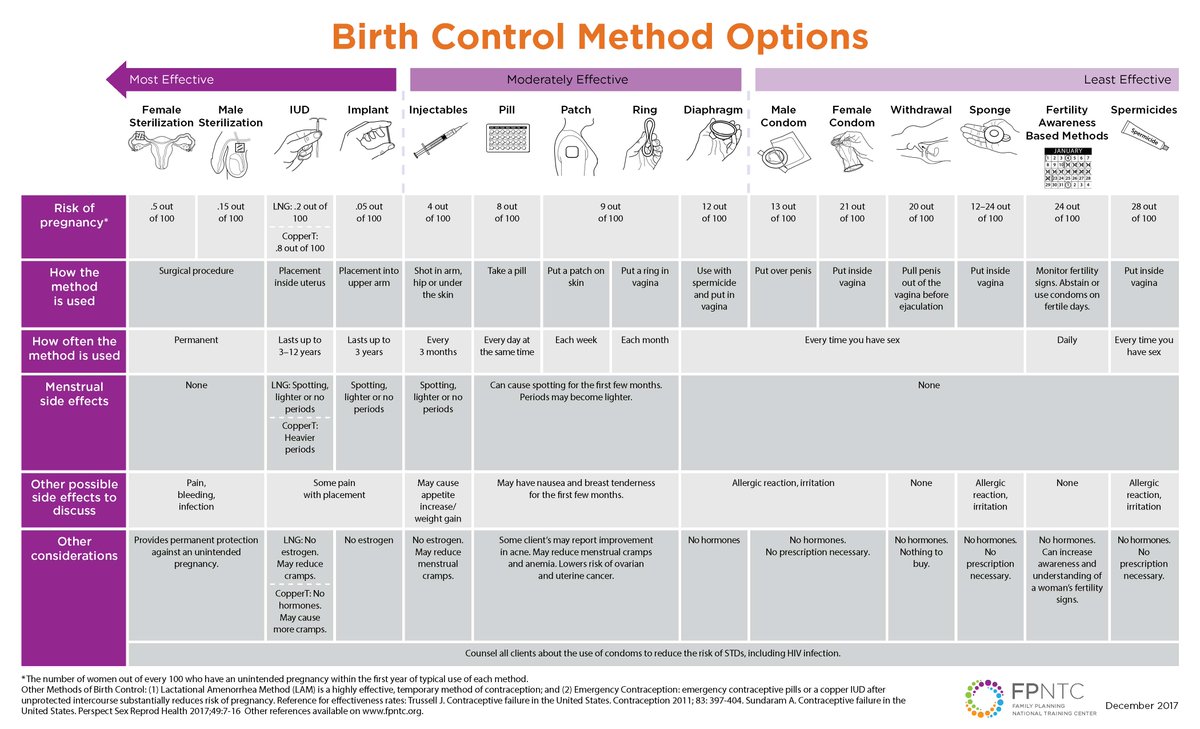 The male condom provides the best protection against most STDs.
The male condom provides the best protection against most STDs.
Female condom
What is it? The female condom is a lubricated polyurethane (plastic) tube that has a flexible ring at each end. One end of the tube is closed.
How is it used? Before sexual activity begins, the woman inserts the condom into her vagina so that the closed end of the tube covers the cervix, and the other end slightly covers the labia (lips on the outside of the vagina). The condom blocks sperm from entering the womb.
How can I get it? Like the male condom, the female condom is available at drug stores without a prescription.
How effective is it? About 21 percent of women get pregnant each year despite using a female condom, but the condom can be more effective when used exactly as instructed.
You should know: Female condoms provide some protection against STDs, but the male condom provides the best protection. Female condom can be used while menstruating. It needs to be removed immediately after sex.
Female condom can be used while menstruating. It needs to be removed immediately after sex.
Sponge
What is it? The sponge is a small, donut-shaped device that is coated with spermicide.
How does it work? The sponge is moistened with water and inserted into the vagina. It is made of polyurethane foam that feels like natural vaginal tissue. The sponge protects against pregnancy in three ways:
- The sponge releases a spermicide to kill sperm cells.
- The sponge is constructed to trap and absorb semen before the sperm have a chance to enter the cervix.
- It acts as a barrier between the sperm and the cervix.
How is it available? The sponge is available without a prescription at most drug stores.
How effective is it? About 32 percent of women who have had babies in the past will get pregnant each year despite using the sponge, but they can be more effective when used exactly as instructed. In comparison, nine to 16 percent of women who have never had a child will get pregnant each year using the sponge, depending on how correctly it is used.
In comparison, nine to 16 percent of women who have never had a child will get pregnant each year using the sponge, depending on how correctly it is used.
You should know: The sponge provides a continuous presence of spermicide throughout a 24-hour period, allowing for multiple acts of intercourse within that time without the need for additional spermicide. The sponge is associated with higher rates of vaginal infections, and is less effective than a diaphragm.
Withdrawal (pullout) method, spermicides (film, jelly, foam, etc.)
These are not effective methods of birth control when used on their own. Out of every five women using these methods to prevent pregnancy, one will get pregnant by the end of the year. Spermicides are used with other barrier methods such as diaphragms and cervical caps to help improve their effectiveness.
Rhythm
What is it? A woman practices rhythm, or natural family planning, by learning to recognize the days she is fertile, and then abstaining from sex before and during those days.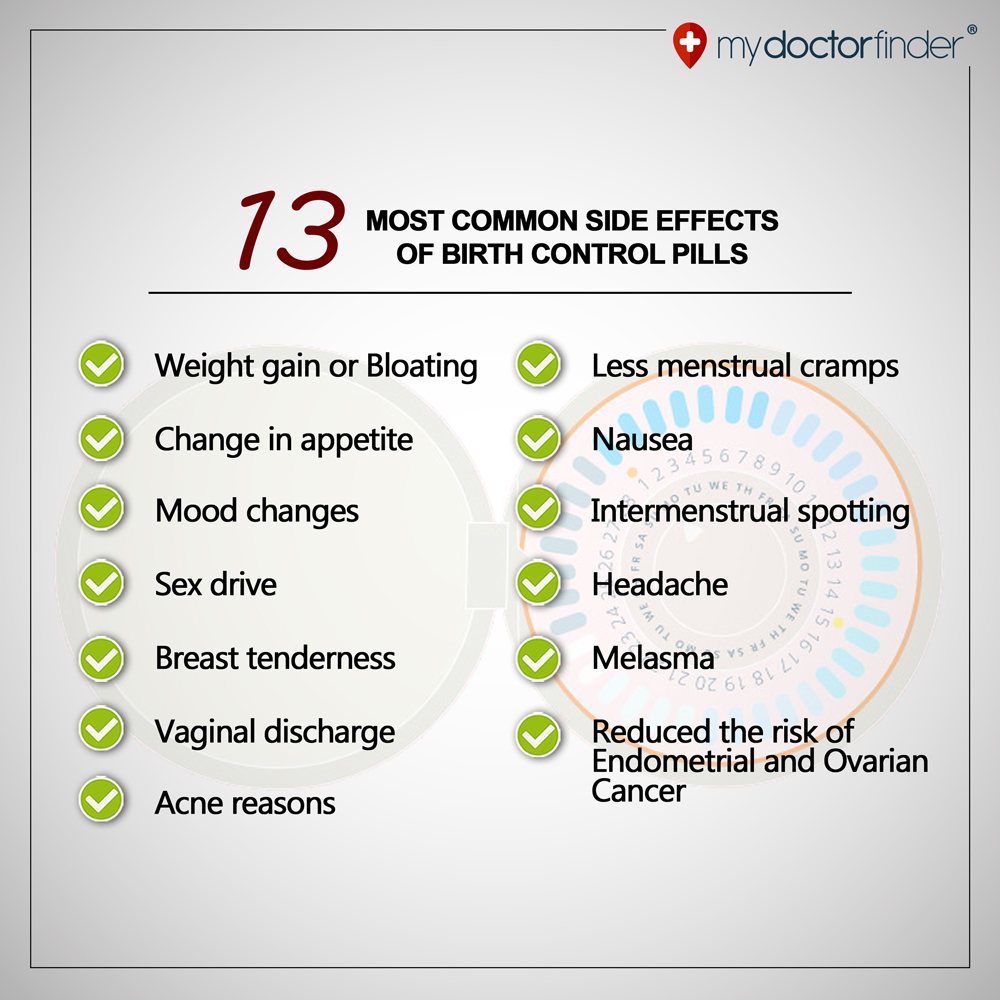
How is it done? Methods include keeping track of changes in body temperature and vaginal discharge (fluid from the vagina.)
How is it learned? Your healthcare provider can describe how to practice natural family planning.
How effective is it? Using the rhythm method, up to 25 percent of women get accidentally pregnant in one year (some studies quote failure rates as high as 50 percent). If done properly, it can be 90 percent effective.
You should know: Natural family planning also can be used to help a woman get pregnant by pinpointing her most fertile times. It also has no side effects and is inexpensive. The rhythm method does not work for all couples. Women who have regular menstrual cycles and who are very careful about when they have sex usually find it to be effective. Women who have irregular cycles and who are not so careful often end up becoming pregnant.
Birth Control – Types, Side Effects, Cost & Effectiveness
Birth control allows people to stop pregnancy before it begins. It is also called contraception. About 99 percent of American women ages 15 to 44 who have ever had sexual intercourse have used contraceptives.
It is also called contraception. About 99 percent of American women ages 15 to 44 who have ever had sexual intercourse have used contraceptives.
Some birth control methods are more effective than others. Their cost varies, too. Abstinence is the only method that is 100 percent effective and free.
Not all types of birth control protect people from sexually transmitted diseases, or STDs. Only latex condoms and abstinence protect people from STDs.
Most types of birth control are relatively safe for women’s health and men’s health. But some may have serious side effects.
Certain birth control side effects led women to file personal injury lawsuits.
Types of Birth Control
There are several types of birth control. These range from birth control pills to sterilization by tubal ligation or vasectomy. Most types of birth control are for women, but there are also options for men.
Each type of contraception has its own side effects, benefits and effectiveness.
Main Types of Birth Control
- Hormonal (birth control pills, NuvaRing, patches and shots)
-
Barrier methods (condoms) -
Intrauterine devices (IUDs) (copper and hormonal) -
Surgical (tubal ligation, vasectomy) -
Implants (Essure, Norplant, Nexplanon) -
Emergency contraception (Plan B)
Hormonal Birth Control: Pills and NuvaRing
Hormonal birth control is the most popular type of birth control in the U.S. These methods include the pill, the patch, a shot and NuvaRing.
They work by releasing estrogen, progestin or a combination of both.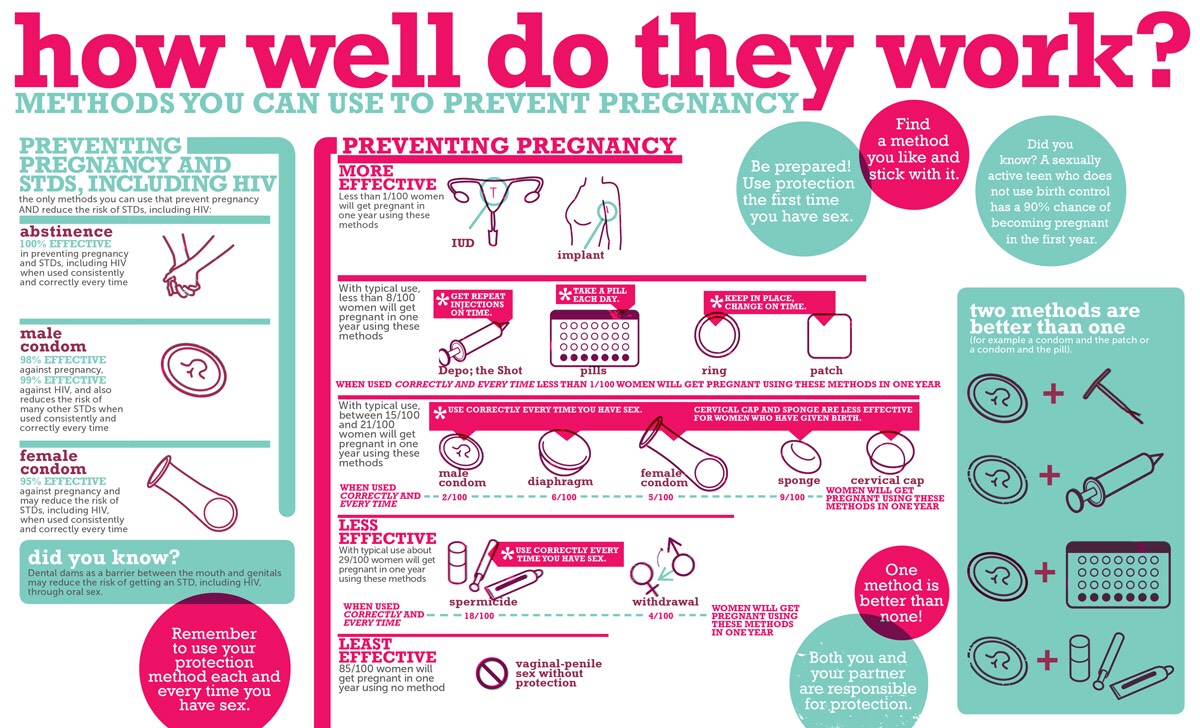 These hormones stop the woman’s body from releasing an egg.
These hormones stop the woman’s body from releasing an egg.
They may also thicken cervical mucus. Thick mucus makes it difficult for the sperm to reach the egg.
Yaz Birth Control and Other Birth Control Pills
Several brands of birth control pills are available to women in the U.S. Women must take the pill every day to prevent pregnancy.
Most side effects of birth control pills are mild and go away after two or three months.
But some brands might have more side effects than others. For example, all combination birth control pills, including Yaz, have a warning for an increased risk for blood clots and strokes, especially in women who smoke cigarettes and are over the age of 35. Yaz and other birth control pills that contain the hormone drospirenone may have a greater risk for these side effects than other birth control pills.
Older oral contraceptives “appear to be a safer choice with regard to venous thromboembolism (blood clots) than preparations containing drospirenone,” Dr. Susan Jick of Boston University’s School of Medicine said in a study in British Medical Journal.
Susan Jick of Boston University’s School of Medicine said in a study in British Medical Journal.
There have been thousands of Yaz lawsuits. Women accuse the pill’s maker, Bayer, of intentionally hiding the drug’s risks.
Yaz is one brand of the birth control pill.
Birth Control Pills at a Glance
- Effectiveness: 91 percent effective
-
Side Effects: Headaches, changes in sexual desire, bloating, changes in mood, weight changes, irregular bleeding, breast tenderness, blood clots -
Average Cost: $0 to $50
NuvaRing Birth Control
NuvaRing is a flexible ring that contains estrogen and progestin hormones.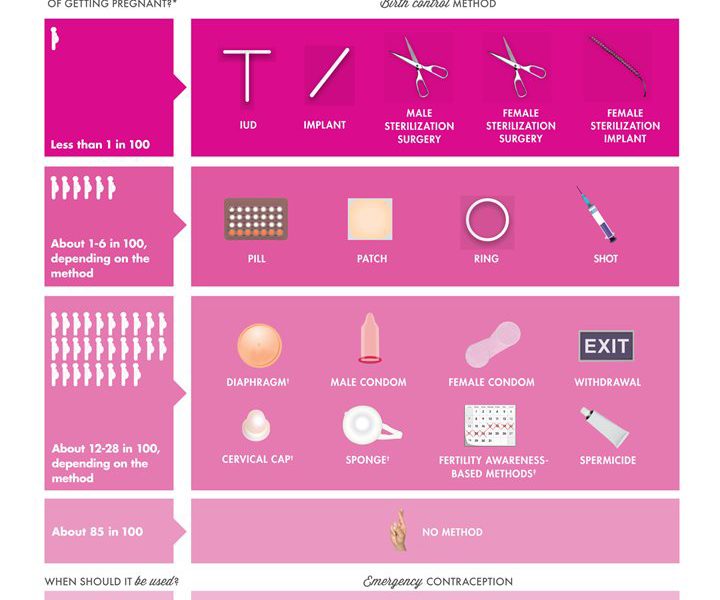 Women insert a new ring into their vaginas every month.
Women insert a new ring into their vaginas every month.
They may choose to wear it all month and not get a period. Or women can remove NuvaRing in the fourth week to get a period.
Minor NuvaRing side effects go away in a few months. Serious side effects can have lasting effects. Nuvaring increases the risk of heart attack, stroke and blood clots, especially in women over 35 who smoke.
NuvaRing is a type of hormonal birth control.
NuvaRing at a Glance
- Effectiveness: 91 percent
-
Side Effects: Irregular period, depression, headache, changes in weight, breast tenderness, increased body hair, loss of scalp hair, increased vaginal wetness -
Average Cost: $0 to $200
Birth Control Patch
The birth control patch contains estrogen and progestin. Women may wear it on their buttocks, upper arm or lower abdomen. The birth control patch gets changed every three weeks.
Women may wear it on their buttocks, upper arm or lower abdomen. The birth control patch gets changed every three weeks.
Women over 35 who smoke may have an increased risk of blood clots or heart problems with use of the patch.
The patch is a hormonal birth control method.
The Patch at a Glance
- Effectiveness: 91 percent
-
Side Effects: Headaches, changes in sexual desire, bloating, changes in mood, weight gain, irregular bleeding, breast tenderness, blood clots, skin irritation -
Average Cost: $0 to $150
Birth Control Shot
The birth control shot (Depo-Provera) is a progestin injection. A doctor or a nurse administers the birth control shot.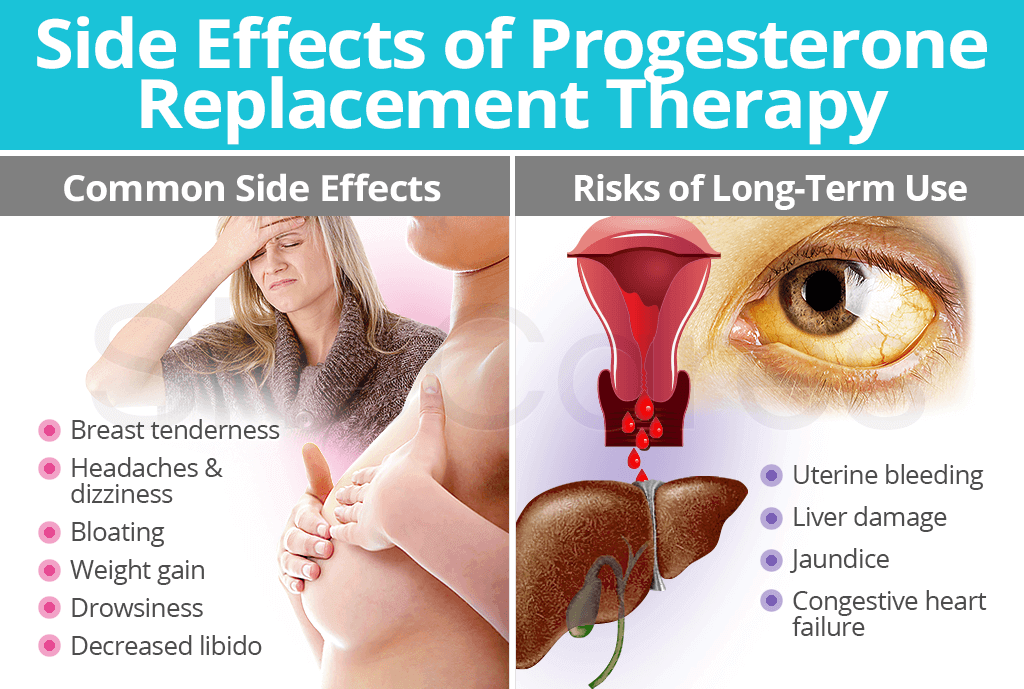
Women using this method get a birth control shot every three months. It causes an increased risk of bone thinning.
The birth control shot is a progestin injection given by a doctor or nurse every three months.
The Shot at a Glance
- Effectiveness: 94 percent
-
Side Effects: Headaches, changes in appetite, weight gain, increased spotting, irregular periods (first six to 12 months), nausea, changes in sex drive, bone thinning, depression -
Average Cost: $0 to $100
Barrier Method: Condoms
After the pill, condoms are the most popular type of reversible birth control. Condoms are small pouches made of latex, plastic or lambskin.
Condoms are small pouches made of latex, plastic or lambskin.
Men wear condoms over the penis. Female condoms (FC2 Female Condom) go inside the vagina. Both types prevent sperm from entering the vagina.
Generally, condoms don’t have many side effects. But, some manufacturers cover condoms in talcum powder.
Some studies show genital exposure to talcum powder may increase the risk of ovarian cancer.
Condoms are a popular birth control method.
Condoms at a Glance
- Effectiveness: 79 percent to 85 percent
-
Side Effects: Skin irritation (from lubricants, spermicides or latex) and possible ovarian cancer (from talcum powder) -
Cost: $0 to $2
Intrauterine Devices (IUDs): Mirena and Paragard
Intrauterine devices or IUDs are small, T-shaped plastic devices inserted into the uterus.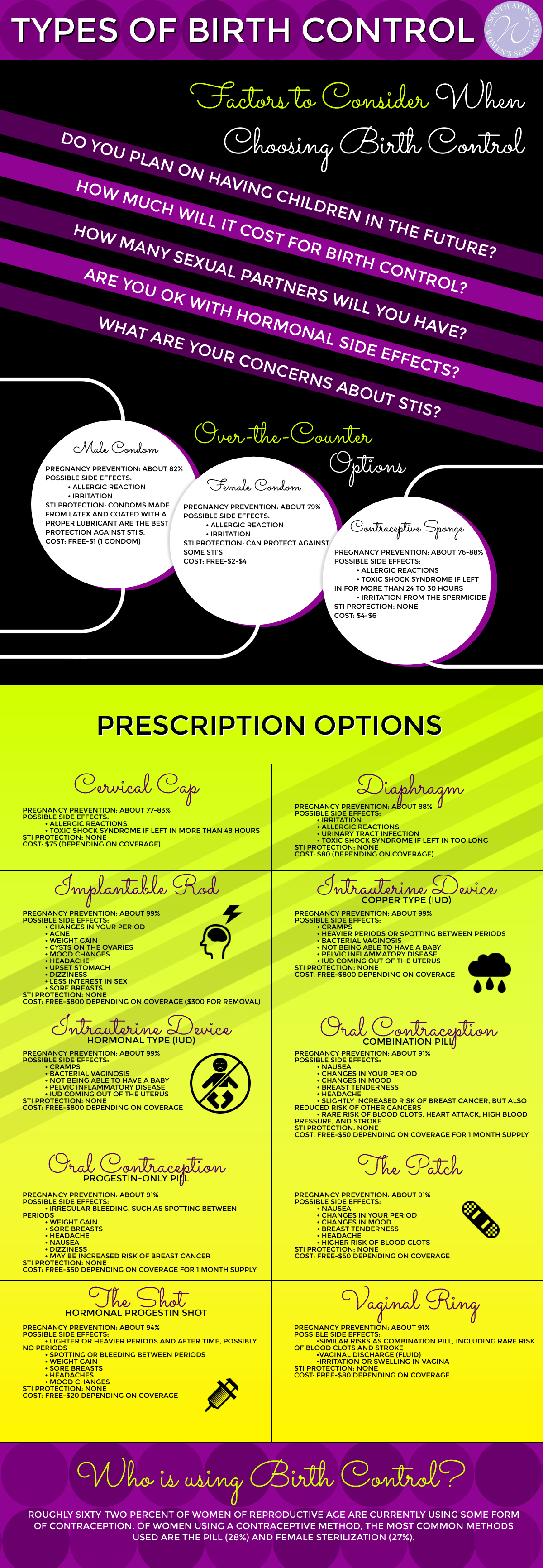 The FDA approved five IUD brands for sale in the U.S.: Mirena, Kyleena, Liletta, Skyla and Paragard.
The FDA approved five IUD brands for sale in the U.S.: Mirena, Kyleena, Liletta, Skyla and Paragard.
Mirena, Kyleena, Liletta and Skyla
Mirena, Kyleena, Liletta and Skyla use progestin hormones to prevent pregnancy. They stop egg production in the ovaries.
The most popular IUD on the market is Mirena (levonorgestrel). It is very effective at preventing pregnancy. But, women have reported serious side effects from using Mirena.
It is also linked to a rare disorder called intracranial hypertension. This is also called pseudotumor cerebri. The condition mimics the effects of a brain tumor.
Paragard
Unlike Mirena birth control and other IUDs, Paragard doesn’t contain hormones. It uses copper to prevent pregnancy for up to 12 years. The copper prevents sperm from getting to the egg.
Paragard also works well for emergency contraception. Health care providers must insert it within five days of unprotected sex for it to work.
Mirena is an intrauterine device, or IUD.
IUDs at a Glance
- Effectiveness: 99 percent
-
Side Effects: Infections, device migration, device expulsion, ectopic pregnancy (pregnancy outside the uterus), organ perforation, cramping, irregular periods, heavy bleeding (ParaGuard), pain during sex, removal may require surgery, pelvic inflammatory disease (PID) -
Cost: $0 to $1,300
Paragard Removal Complications
Some patients experience serious side effects upon removal of their Paragard IUD. Read more about potential complications.
Learn More
Permanent Birth Control Surgery: Tubal Ligation and Vasectomy
Tubal ligation (tying the tubes) and vasectomy are two main birth control surgeries. Both procedures are permanent.
Both procedures are permanent.
Tubal ligation permanently closes or blocks the fallopian tubes. Vasectomy cuts or blocks the tubes that carry sperm.
Generally, vasectomy costs less and has fewer complications than tubal ligation.
Tubal ligation and vasectomy are permanent birth control surgeries.
Surgical Birth Control at a Glance
- Effectiveness: 99 percent
-
Side Effects: Surgical complications, ectopic pregnancy, infections -
Cost: $0 to $1,000 (vasectomy), $0 to $6,000 (tubal ligation)
Birth Control Implants: Essure, Nexplanon
Birth control implants can be permanent or temporary. For example Essure is a permanent birth control implant. It is a non-surgical form of female sterilization.
For example Essure is a permanent birth control implant. It is a non-surgical form of female sterilization.
Doctors insert a metal coil with plastic fibers in each fallopian tube. After three weeks, scar tissue blocks each tube.
The Essure procedure “took a long time, and it was painful,” Angie Firmalino, who underwent the procedure in 2009, told Drugwatch.
Thousands of women say they experienced serious side effects from Essure birth control. Reported injuries range from severe pelvic pain to autoimmune disorders. There are about 35,000 women in one support group called Essure Problems.
Nexplanon is a matchstick-size hormonal birth control implant that goes into the upper arm. It releases a progestin hormone and prevents pregnancy for up to four years.
An older, similar birth control implant called Norplant is no longer available in the U.S. Women filed lawsuits claiming the company did not warn them of serious side effects.
One woman told Drugwatch she developed a tumor from Norplant.
Implants at a Glance
- Effectiveness: 99 percent
-
Essure Side Effects: Pelvic pain, autoimmune disorders, dizziness, cramping, vomiting, device expulsion, device migration, abnormal bleeding, painful intercourse, headaches, body pain, additional surgeries for removal, hysterectomy. -
Nexplanon Side Effects: Changes in period, weight gain, liver disease, weight gain, depression, increased blood sugar, gallbladder disease, ovarian cysts, acne. -
Cost: $0 to $2,500
Essure is a permanent birth control implant.
Emergency Contraception: Plan B
Emergency contraception can prevent pregnancy after unprotected sex. These contraceptives are also called “morning after pills.”
These contraceptives are also called “morning after pills.”
The most popular brand is Plan B. Other brands are Take Action, Next Choice One-Dose and My Way.
Emergency contraception is available without a prescription. This is unlike most other types of birth control.
Women have to take emergency contraception within five days of unprotected sex for it to work. It works best within three days.
Paragard copper IUDs also work as emergency contraception.
Plan B is emergency contraception that can prevent pregnancy after unprotected sex.
Plan B at a Glance
- Effectiveness: 75 percent to 89 percent
-
Side Effects: Nausea, vomiting, abdominal pain, dizziness, menstrual pain, breast tenderness, headache, fatigue, irregular bleeding -
Cost: $0 to $60
Please seek the advice of a medical professional before making health care decisions.
Share This Page:
https://www.drugwatch.com/health/birth-control/Copy Link
Managing Adverse Effects of Hormonal Contraceptives
1. Moreau C,
Cleland K,
Trussell J.
Contraceptive discontinuation attributed to method dissatisfaction in the United States. Contraception.
2007;76(4):267–272….
2. Bitzer J,
Tschudin S,
Alder J.
Acceptability and side-effects of Implanon in Switzerland: a retrospective study by the Implanon Swiss Study Group. Eur J Contracept Reprod Health Care.
2004;9(4):278–284.
3. Daud S,
Ewies AA.
Levonorgestrel-releasing intrauterine system: why do some women dislike it? Gynecol Endocrinol.
2008;24(12):686–690.
4. Lopez LM,
Grimes DA,
Gallo MF,
Schulz KF.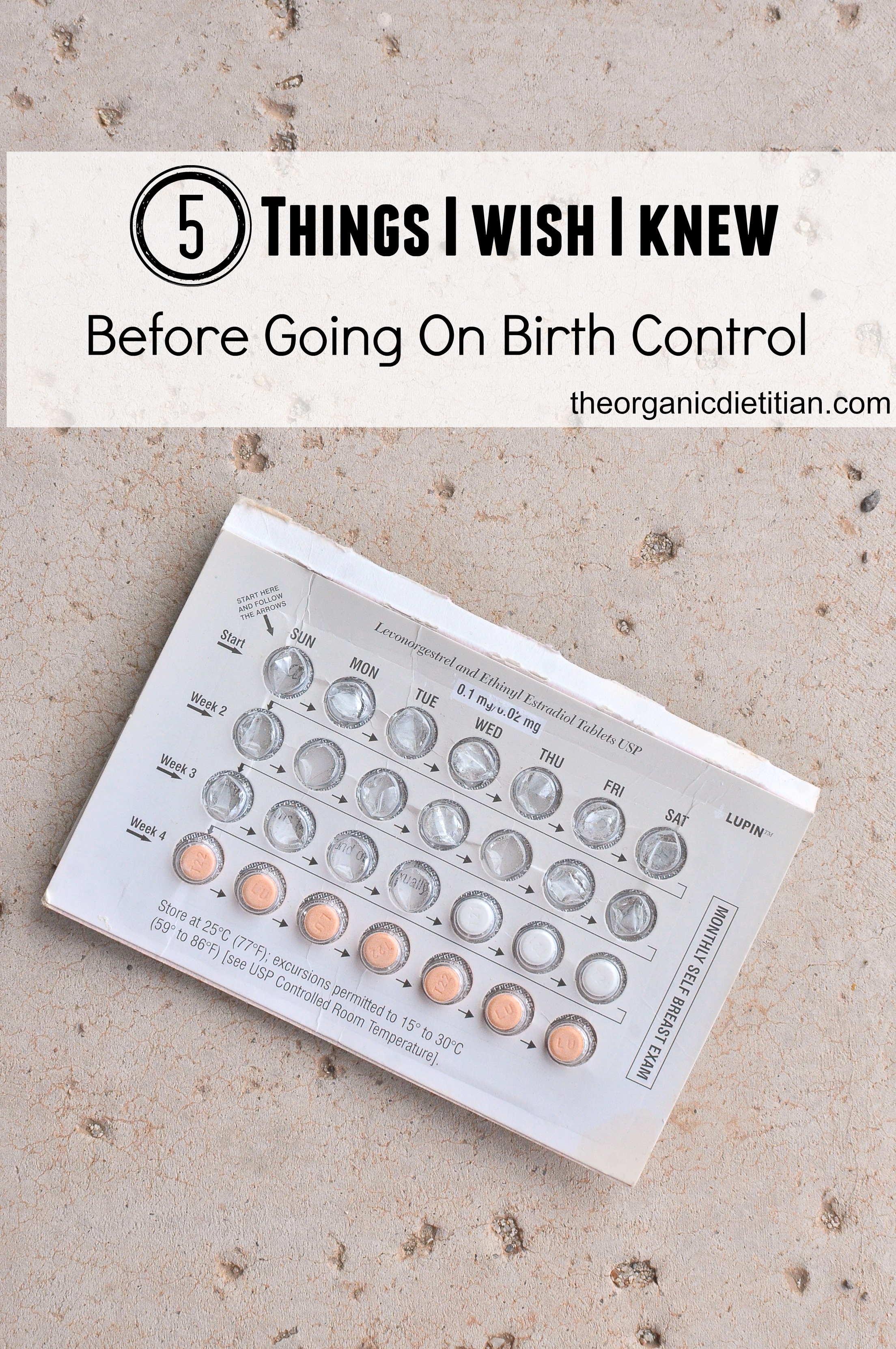
Skin patch and vaginal ring versus combined oral contraceptives for contraception. Cochrane Database Syst Rev.
2010;(3):CD003552.
5. Practice Committee of American Society for Reproductive Medicine.
Hormonal contraception: recent advances and controversies. Fertil Steril.
2008;90(5 suppl):S103–S113.
6. Römer T,
Linsberger D.
User satisfaction with a levonorgestrel-releasing intrauterine system (LNG-IUS): data from an international survey. Eur J Contracept Reprod Health Care.
2009;14(6):391–398.
7. Implanon FAQs. http://www.implanon-usa.com/hcp/patientsupport/faqs/index.asp?C=51154400339891087963&svarqvp2=0#186833. Accessed March 20, 2010.
8. Berenson AB,
Odom SD,
Breitkopf CR,
Rahman M.
Physiologic and psychologic symptoms associated with use of injectable contraception and 20 microg oral contraceptive pills. Am J Obstet Gynecol.
2008;199(4):351. e1–351.e12.
e1–351.e12.
9. Moreau C,
Trussell J,
Gilbert F,
Bajos N,
Bouyer J.
Oral contraceptive tolerance: does the type of pill matter? Obstet Gynecol.
2007;109(6):1277–1285.
10. Gallo MF,
Nanda K,
Grimes DA,
Lopez LM,
Schulz KF.
20 microg versus >20 microg estrogen combined oral contraceptives for contraception. Cochrane Database Syst Rev.
2008;(4):CD003989.
11. Miller L,
Hughes JP.
Continuous combination oral contraceptive pills to eliminate withdrawal bleeding: a randomized trial. Obstet Gynecol.
2003;101(4):653–661.
12. Edelman AB,
Koontz SL,
Nichols MD,
Jensen JT.
Continuous oral contraceptives: are bleeding patterns dependent on the hormones given? Obstet Gynecol.
2006;107(3):657–665.
13. Sabatini R,
Cagiano R.
Comparison profiles of cycle control, side effects and sexual satisfaction of three hormonal contraceptives.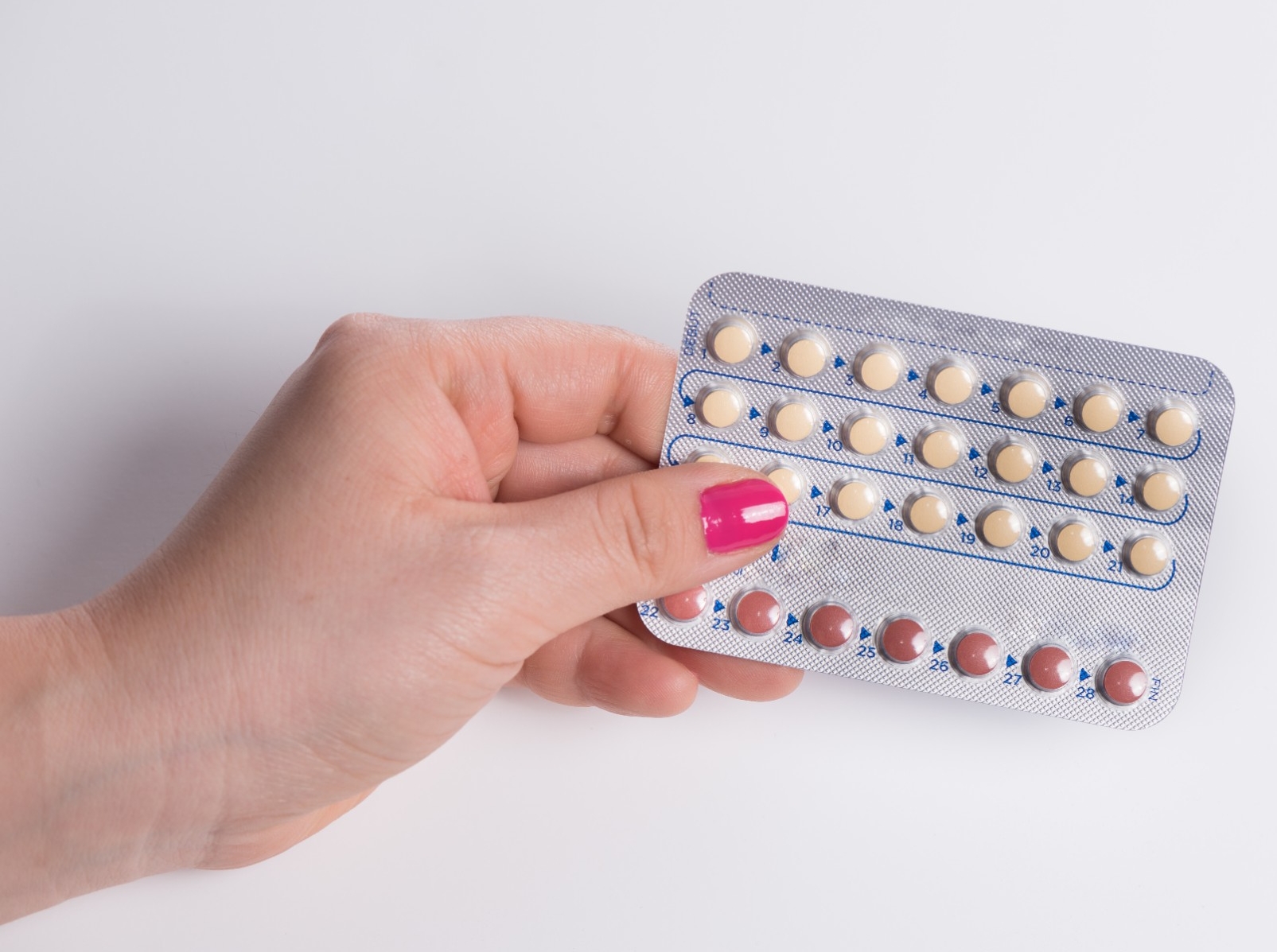 Contraception.
Contraception.
2006;74(3):220–223.
14. Civic D,
Scholes D,
Ichikawa L,
et al.
Depressive symptoms in users and non-users of depot medroxyprogesterone acetate. Contraception.
2000;61(6):385–390.
15. ACOG Committee on Practice Bulletins–Gynecology.
ACOG practice bulletin no. 73: use of hormonal contraception in women with coexisting medical conditions. Obstet Gynecol.
2006;107(6):1453–1472.
16. Loder EW,
Buse DC,
Golub JR.
Headache as a side effect of combination estrogen-progestin oral contraceptives: a systematic review. Am J Obstet Gynecol.
2005;193(3 pt 1):636–649.
17. Edelman AB,
Gallo MF,
Jensen JT,
Nichols MD,
Schulz KF,
Grimes DA.
Continuous or extended cycle vs. cyclic use of combined oral contraceptives for contraception. Cochrane Database Syst Rev.
2005;(3): CD004695.
18. Sulak P,
Willis S,
Kuehl T,
Coffee A,
Clark J.
Headaches and oral contraceptives: impact of eliminating the standard 7-day placebo interval. Headache.
2007;47(1):27–37.
19. Task Force on Postovulatory Methods of Fertility Regulation.
Randomised controlled trial of levonorgestrel versus the Yuzpe regimen of combined oral contraceptives for emergency contraception. Lancet.
1998;352(9126):428–433.
20. Berenson AB,
Rahman M.
Changes in weight, total fat, percent body fat, and central-to-peripheral fat ratio associated with injectable and oral contraceptive use. Am J Obstet Gynecol.
2009;200(3):329. e1–329. e8.
21. Gallo MF,
Grimes DA,
Schulz KF,
Helmerhorst FM.
Combination estrogen- progestin contraceptives and body weight: systematic review of randomized controlled trials. Obstet Gynecol.
2004;103(2):359–373.
22. Gallo MF,
Lopez LM,
Grimes DA,
Schulz KF,
Helmerhorst FM.
Combination contraceptives: effects on weight. Cochrane Database Syst Rev.
2008;(4):CD003987.
23. Schaffir J.
Hormonal contraception and sexual desire: a critical review. J Sex Marital Ther.
2006;32(4):305–314.
24. Workowski KA,
Berman SM;
Centers for Disease Control and Prevention.
Sexually transmitted diseases treatment guidelines, 2006 [published correction appears in MMWR Recomm Rep. 2006;55(36):997]. MMWR Recomm Rep.
2006;55(RR-11):1–94.
25. World Health Organization. Medical eligibility criteria for contraceptive use. 4th ed, 2009. http://www.who.int/reproductivehealth/publications/family_planning/9789241563888/en/index.html. Accessed March 20, 2010.
26. Blümel JE,
Castelo-Branco C,
Binfa L,
Aparicio R,
Mamani L.
A scheme of combined oral contraceptives for women more than 40 years old.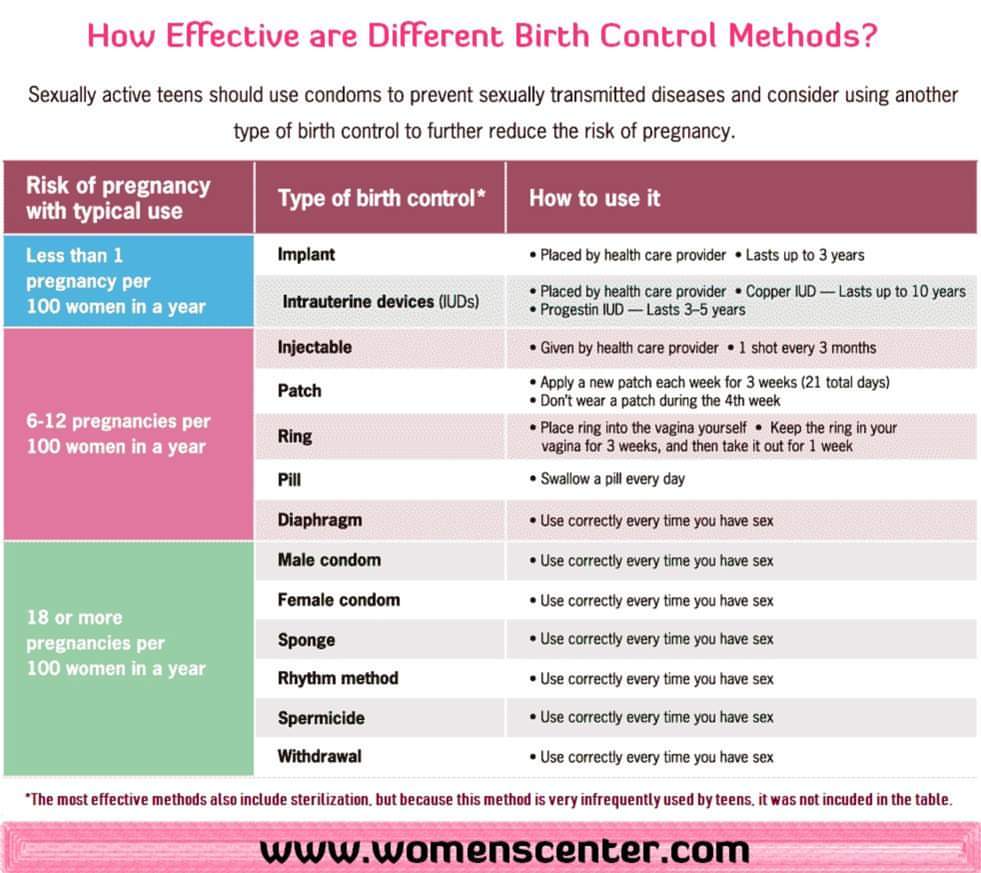 Menopause.
Menopause.
2001;8(4):286–289.
27. Coffee AL,
Sulak PJ,
Kuehl TJ.
Long-term assessment of symptomatology and satisfaction of an extended oral contraceptive regimen. Contraception.
2007;75(6):444–449.
28. Martin KA,
Chang RJ,
Ehrmann DA,
et al.
Evaluation and treatment of hirsutism in premenopausal women: an Endocrine Society clinical practice guideline. J Clin Endocrinol Metab.
2008;93(4):1105–1120.
29. Ragan RE,
Rock RW,
Buck HW.
Metoclopramide pretreatment attenuates emergency contraceptive-associated nausea. Am J Obstet Gynecol.
2003;188(2):330–333.
30. Raymond EG,
Creinin MD,
Barnhart KT,
Lovvorn AE,
Rountree RW,
Trussell J.
Meclizine for prevention of nausea associated with use of emergency contraceptive pills: a randomized trial. Obstet Gynecol.
2000;95(2):271–277.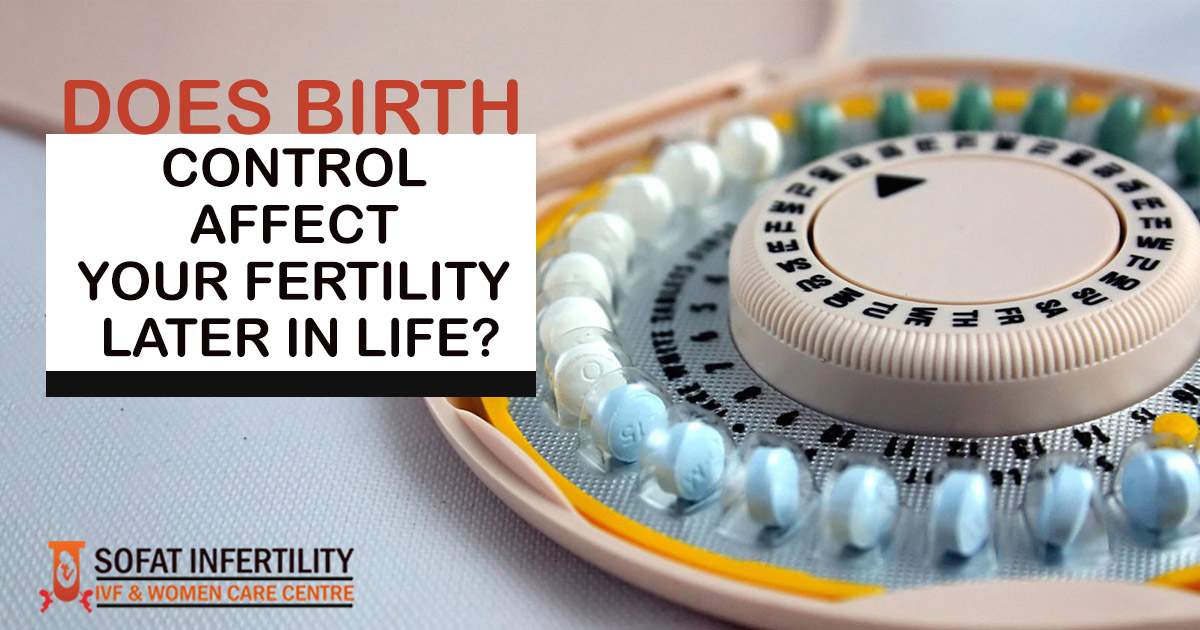
31. Weisberg E,
Hickey M,
Palmer D,
et al.
A randomized controlled trial of treatment options for troublesome uterine bleeding in Implanon users. Hum Reprod.
2009;24(8):1852–1861.
32. Weisberg E,
Hickey M,
Palmer D,
et al.
A pilot study to assess the effect of three short-term treatments on frequent and/or prolonged bleeding compared to placebo in women using Implanon. Hum Reprod.
2006;21(1):295–302.
33. Van Vliet HA,
Grimes DA,
Helmerhorst FM,
Schulz KF.
Biphasic versus triphasic oral contraceptives for contraception. Cochrane Database Syst Rev.
2006;(3):CD003283.
34. Arowojolu AO,
Gallo MF,
Lopez LM,
Grimes DA,
Garner SE.
Combined oral contraceptive pills for treatment of acne. Cochrane Database Syst Rev.
2009;(3):CD004425.
35. Maitra N,
Kulier R,
Bloemenkamp KW,
Helmerhorst FM,
Gülmezoglu AM.
Progestogens in combined oral contraceptives for contraception. Cochrane Database Syst Rev.
2004;(3):CD004861.
36. Van Vliet HA,
Grimes DA,
Lopez LM,
Schulz KF,
Helmerhorst FM.
Triphasic versus monophasic oral contraceptives for contraception. Cochrane Database Syst Rev.
2006;(3):CD003553.
37. Sulak PJ,
Smith V,
Coffee A,
Witt I,
Kuehl AL,
Kuehl TJ.
Frequency and management of breakthrough bleeding with continuous use of the transvaginal contraceptive ring: a randomized controlled trial. Obstet Gynecol.
2008;112(3):563–571.
38. Abdel-Aleem H,
d’Arcangues C,
Vogelsong KM,
Gülmezoglu AM.
Treatment of vaginal bleeding irregularities induced by progestin only contraceptives. Cochrane Database Syst Rev.
2007;(4):CD003449.
39. World Health Organization. Selected practice recommendations for contraceptive use: 2008 update.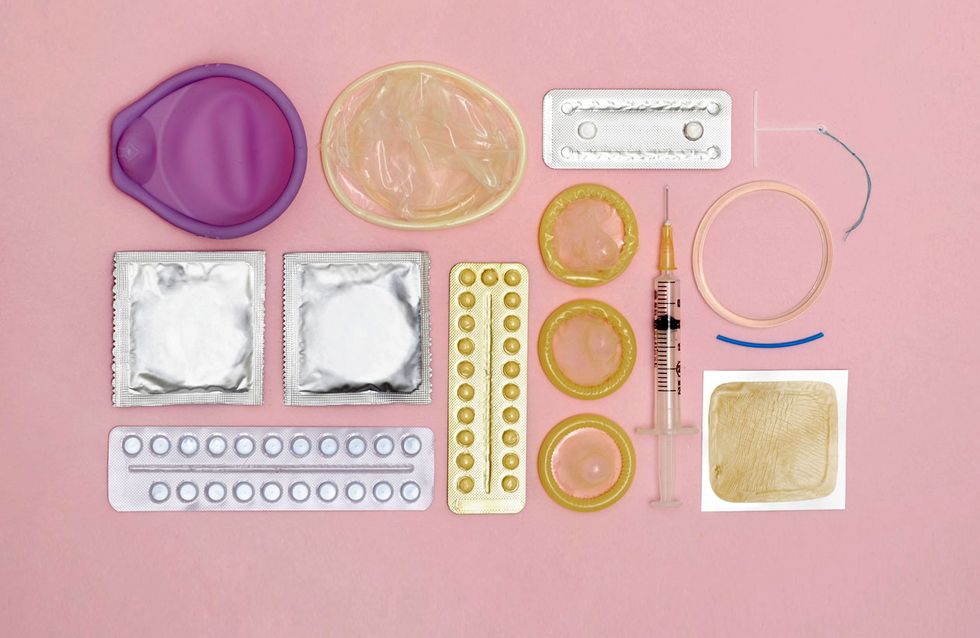 http://whqlibdoc.who.int/hq/2008/WHO_RHR_08.17_eng.pdf. Accessed March 20, 2010.
http://whqlibdoc.who.int/hq/2008/WHO_RHR_08.17_eng.pdf. Accessed March 20, 2010.
40. World Health Organization. Selected practice recommendations for contraceptive use. 2nd ed., 2004. http://whqlibdoc.who.int/publications/2004/9241562846.pdf. Accessed March 20, 2010.
41. Breitkopf DM,
Rosen MP,
Young SL,
Nagamani M.
Efficacy of second versus third generation oral contraceptives in the treatment of hirsutism. Contraception.
2003;67(5):349–353.
42. Truitt ST,
Fraser AB,
Grimes DA,
Gallo MF,
Schulz KF.
Combined hormonal versus nonhormonal versus progestin-only contraception in lactation. Cochrane Database Syst Rev.
2003;(2):CD003988.
43. World Health Organization. Technical consultation on hormonal contraceptive use during lactation and effects on the newborn: summary report. http://whqlibdoc.who.int/hq/2010/WHO_RHR_10.05_eng.pdf. Accessed March 24, 2010.
44. Halderman LD,
Halderman LD,
Nelson AL.
Impact of early postpartum administration of progestin-only hormonal contraceptives compared with nonhormonal contraceptives on short-term breast-feeding patterns. Am J Obstet Gynecol.
2002;186(6):1250–1256.
Birth control options: Things to consider
Birth control options: Things to consider
Choosing a method of birth control can be difficult. Know the options and how to pick the type of contraception that’s right for you.
By Mayo Clinic Staff
If you’re considering using birth control (contraception), you have a variety of options. To help pick the right method of birth control for you and your partner, consider the following questions.
What birth control options are available?
Your birth control options include:
- Barrier methods. Examples include male and female condoms, as well as the diaphragm, cervical cap and contraceptive sponge.

- Short-acting hormonal methods. Examples include birth control pills, as well as the vaginal ring (NuvaRing), skin patch (Xulane) and contraceptive injection (Depo-Provera). These are considered short-acting methods because you have to remember to use them on a daily, weekly or monthly basis.
- Long-acting hormonal methods. Examples include the copper IUD (ParaGard), the hormonal IUD (Mirena, Skyla, Kyleena, others) and the contraceptive implant (Nexplanon). These are considered long-acting methods because they last for three to 10 years after insertion — depending on the device — or until you decide to have the device removed.
- Sterilization. This is a permanent method of birth control. Examples include tubal ligation for women and vasectomy for men.
- Fertility awareness methods. These methods focus on knowing which days of the month you are able to get pregnant (fertile), often based on basal body temperature and cervical mucus.
 To avoid getting pregnant, you do not have sex on or around the days you are fertile, or you use a barrier method of birth control.
To avoid getting pregnant, you do not have sex on or around the days you are fertile, or you use a barrier method of birth control.
It’s also important to be aware of emergency contraception — such as the morning-after pill (Plan B One-Step, Aftera, ella, others) — which can be used to prevent pregnancy after unprotected sex.
How do the different birth control options work?
Various types of birth control work in different ways. Birth control methods may:
- Prevent sperm from reaching the egg
- Inactivate or damage sperm
- Prevent an egg from being released each month
- Alter the lining of the uterus so that a fertilized egg doesn’t attach to it
- Thicken cervical mucus so that sperm can’t easily pass through it
What is the method’s effectiveness?
To be effective, any method of contraception must be used consistently and correctly. Contraceptives that require little effort on your part, such as IUDs, contraceptive implants and sterilization, are associated with lower pregnancy rates.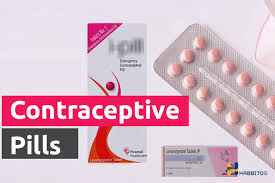 In contrast, methods that require monitoring fertility or periodic abstinence are associated with higher pregnancy rates.
In contrast, methods that require monitoring fertility or periodic abstinence are associated with higher pregnancy rates.
Is it reversible?
The method of contraception you choose depends on your reproductive goals. If you’re planning pregnancy in the near future, you may want a method that’s easily stopped or quickly reversible, such as a short-acting hormonal method or a barrier method. If you want to prevent pregnancy for a longer amount of time, you may consider a long-acting method, such as an IUD. If you’re certain that you don’t want to get pregnant at any time in the future, you may prefer a permanent method, such as sterilization. You may find that different contraceptive options work for you at different stages of your life.
Is it compatible with your religious beliefs or cultural practices?
Some forms of birth control are considered a violation of certain religious laws or cultural traditions. Weigh the risks and benefits of a birth control method against your personal convictions.
Is it convenient and affordable?
It’s important to choose a type of birth control that suits your lifestyle. For some people, the most convenient form of birth control may be one that is easy to use, has no bothersome side effects or does not disrupt the sexual experience. For others, convenience means no prescription is required. When choosing a method of birth control, consider how willing you are to plan ahead or follow a rigid medication schedule.
Some methods of contraception are inexpensive, while others are more costly. Ask your insurance provider about your coverage, and then consider the expense as you make a decision.
What are the side effects?
Consider your tolerance for the possible side effects associated with a particular birth control method. Some methods pose more side effects — some potentially serious — than others. Talk to your doctor about your medical history and how it might affect your choice of birth control.
Does it protect against sexually transmitted infections?
Male and female condoms are the only methods of birth control that offer reliable protection from sexually transmitted infections. Unless you are in a mutually monogamous relationship and have been tested for sexually transmitted infections, use a new condom every time you have sex in addition to any other method of birth control you use.
Unless you are in a mutually monogamous relationship and have been tested for sexually transmitted infections, use a new condom every time you have sex in addition to any other method of birth control you use.
Does it offer other benefits?
In addition to preventing pregnancy, some contraceptives provide benefits such as more predictable, lighter menstrual cycles, a decreased risk of sexually transmitted infections or a reduction in the risk of some cancers. If these benefits are important to you, they may influence your choice of birth control option.
Is it acceptable to your sexual partner?
Your partner may have birth control preferences that are similar to or different from your own. Discuss birth control options with your partner to help determine which method is acceptable to both of you.
What’s the bottom line?
The best method of birth control for you is one that is safe, that you are comfortable using, and that you are able to use consistently and correctly. Your preferred method of birth control may change over your lifetime and is influenced by many different factors, including:
Your preferred method of birth control may change over your lifetime and is influenced by many different factors, including:
- Your age and health history
- Your reproductive goals, such as the number of children you want and how soon you want to get pregnant
- Relationship factors, including marital status, number of sexual partners, how often you have sex and partner preferences
- Religious beliefs
- Differences between birth control methods, including how effective they are at preventing pregnancy, side effects, cost and whether they prevent sexually transmitted infections
Knowing your options is definitely part of the decision process — but an honest assessment of yourself and your relationships is just as important when deciding which type of birth control is right for you.
Get the latest health advice from Mayo Clinic delivered
to your inbox.
Sign up for free, and stay up-to-date on research
advancements, health tips and current health topics,
like COVID-19, plus expert advice on managing your health.
Learn more about our use of data
To provide you with the most relevant and helpful information and to understand which
information
is beneficial, we may combine your e-mail and website usage information with other
information we have about you. If you are a Mayo Clinic Patient,
this could include Protected Health Information (PHI). If we combine this information
with your PHI, we will treat all of that information as PHI,
and will only use or disclose that information as set forth in our notice of privacy
practices. You may opt-out of e-mail communications
at any time by clicking on the Unsubscribe link in the e-mail.
Subscribe!
Thank you for Subscribing
Our Housecall e-newsletter will keep you up-to-date
on the latest health information.
We’re sorry! Our system isn’t working.
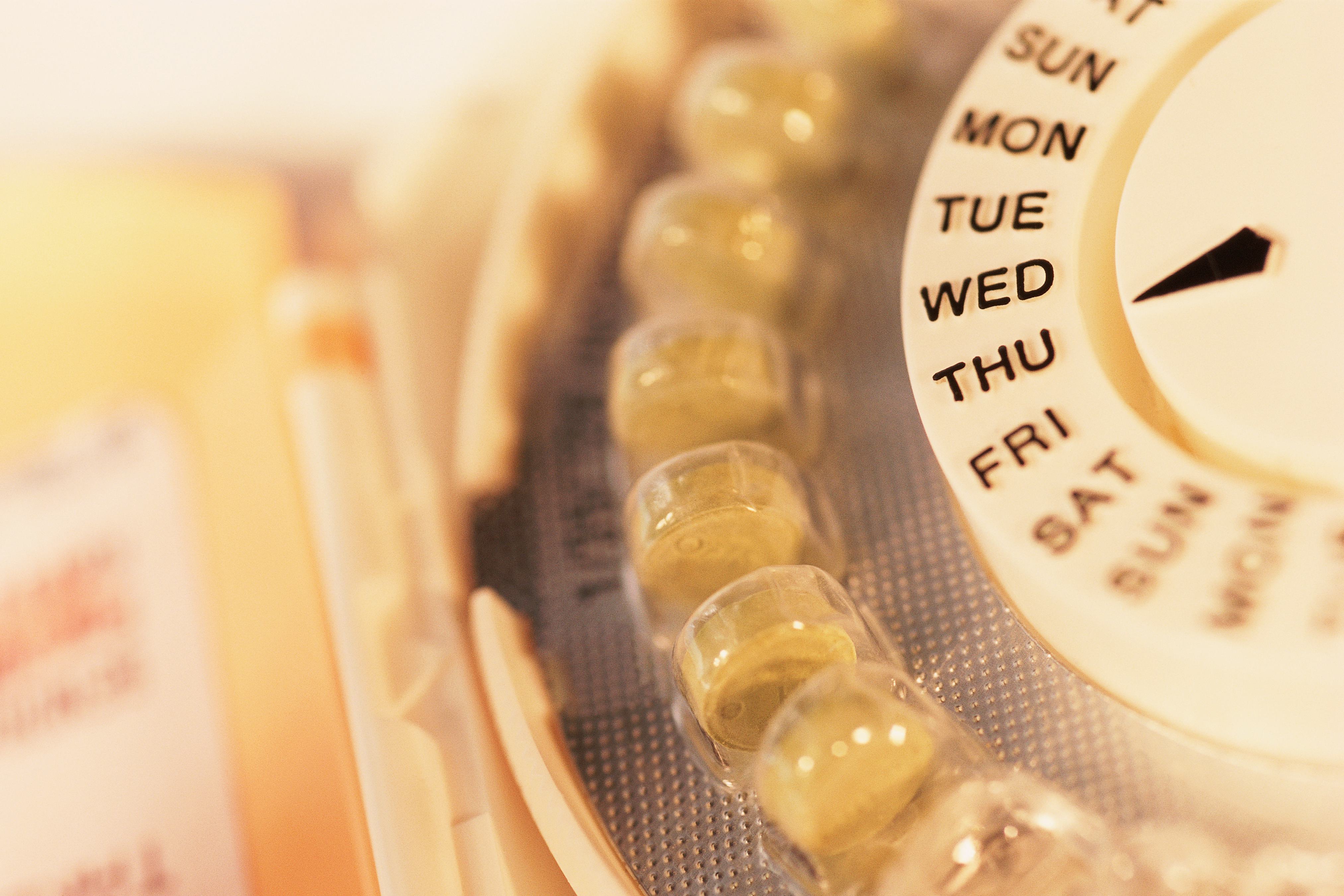 Please try again.
Please try again.
Something went wrong on our side, please try again.
Please try again
Feb. 16, 2018
Show references
- Cullins V. Counseling women considering combined hormonal contraception. http://www.uptodate.com/home. Accessed Jan. 15, 2015.
- Zieman M. Overview of contraception. http://www.uptodate.com/home. Accessed Jan. 15, 2015.
- Hatcher RA, et al. Contraceptive Technology. 20th ed. New York, N.Y.: Ardent Media; 2011:45.
- Jennings V. Fertility awareness-based methods of pregnancy prevention. http://www.uptodate.com/home. Accessed Jan. 15, 2015.
- Dean G, et al. Intrauterine contraception (IUD): Overview. http://www.uptodate.com/home. Accessed Jan. 15, 2015.
See more In-depth
Products and Services
- Newsletter: Mayo Clinic Health Letter — Digital Edition
- Book: Mayo Clinic Family Health Book, 5th Edition
.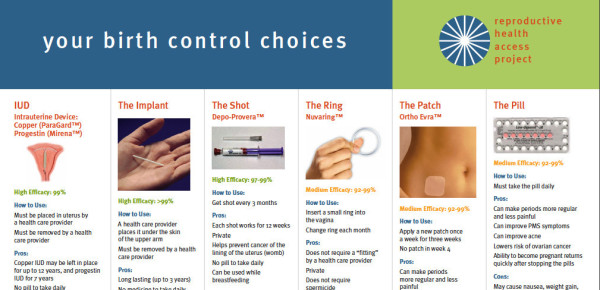
Birth Control | FDA
Print the Birth Control Chart (502 KB)
En Español(1582KB)
This birth control chart provides high-level information about different birth control options. It is meant for educational purposes for the general public. This chart is not meant to be a complete list of all available birth control options. Talk to your healthcare provider about the best birth control choice for you. If you do not want to get pregnant, there are many birth control options to choose from. No one product is best for everyone. Some methods are more effective than others at preventing pregnancy. The only sure way to avoid pregnancy is not to have sex.
Types of Medicines and Devices for Birth Control
Other Contraception
Some things to think about when you choose birth control:
- Your health.

- If you want to have children in the future.
- How often you have sex.
- How many sexual partners you have.
- If you will need a prescription or if you can buy the method over-the-counter.
- The number of pregnancies expected per 100 women who use a method for one year. For comparison, about 85 out of 100 sexually active women who do not use any birth control can expect to become pregnant in a year.
- This page lists pregnancy rates based on typical use. Typical use shows how effective the different methods are during actual use (including sometimes using a method in a way that is not correct or not consistent).
- For more information on the chance of getting pregnant while using a method or on the risks of a specific product, please check the product label or Trussell,J. (2011).”Contraceptive failure in the United States.” Contraception 83(5):397-404.
Tell your doctor, healthcare provider, or pharmacist if you:
To avoid pregnancy:
- No matter which method you choose, it is important to follow all of the directions carefully.
 If you don’t, you increase your chance of getting pregnant.
If you don’t, you increase your chance of getting pregnant. - The best way to avoid pregnancy is to not have any sexual contact.
Sterilization Surgery for Women (also called trans-abdominal surgical sterilization)
What is it?
- One way is by tying and cutting the tubes — this is called tubal ligation.
- The fallopian tubes also can be sealed using an instrument with an electrical current.
- They also can be closed with clips, clamps, or rings.
- Sometimes, a small piece of the tube is removed.
How does it work?
- The fallopian tubes are blocked so the egg and sperm can’t meet in the fallopian tube. This stops you from getting pregnant.
- It is supposed to be permanent.
- Sometimes it is possible to reverse the sterilization. Reversal involves another surgery that might not work.
How do I get it?
- This is surgery.

- You will need general anesthesia.
Chance of getting pregnant with typical use (Number of pregnancies expected per 100 women who use this method for one year)
- Out of 100 women who use this method, less than 1 may get pregnant.
Some Risks
- Pain
- Bleeding
- Infection or other complications after surgery
Does it protect me from sexually transmitted infections (STIs)? No.
Sterilization Surgery for Men (Vasectomy)
This method is for men who are sure they never want to have a child or do not want any more children. If you are thinking about reversal, vasectomy may not be right for you. Sometimes it is possible to reverse the operation, but the likelihood of reversal decreases the more time passes between vasectomy and reversal. Reversal involves complicated surgery that might not work.
What is it?
- This is a surgery a man needs only once.

- It is permanent.
How does it work?
- The surgery blocks a man’s vas deferens (the tubes that carry sperm from the testes).
- After this surgery, the semen (the fluid that comes out of a man’s penis) has no sperm in it.
- It takes about three months to clear sperm out of a man’s system. You need to use another form of birth control until a test shows there are no longer any sperm in the seminal fluid.
How do I get it?
- This is surgery.
- Local anesthesia is used.
Chance of getting pregnant with typical use (Number of pregnancies expected per 100 women who use this method for one year)
- Out of 100 women whose partner has had a vasectomy, less than 1 may get pregnant.
Some Risks
The success of reversal surgery depends on:
- The length of time since the vasectomy was performed.
- Whether or not antibodies to sperm have developed.

- The method used for vasectomy
- Length and location of the segments of vas deferens that were removed or blocked.
Does it protect me from sexually transmitted infections (STIs)? No.
Long-acting Reversible Contraceptives (LARC)
These methods last for several years. If you want to get pregnant, you can stop using them at any time.
IUD or IUS (intrauterine device or system)
Copper IUD
What is it?
- A T-shaped device containing copper that is put into the uterus by a healthcare provider.
How does it work?
- The IUD prevents sperm from reaching the egg, from fertilizing the egg, and may prevent the egg from attaching (implanting) in the womb (uterus).
- It does not stop the ovaries from making an egg (ovulating) each month.
- The copper IUD can be used for up to 10 years.
- After the IUD is taken out, it is possible to get pregnant.

How do I get it?
- A doctor or other healthcare provider needs to put in the IUD.
Chance of getting pregnant with typical use (Number of pregnancies expected per 100 women who use this method for one year)
- Out of 100 women who use this method, less than 1 may get pregnant.
Some Side Effects
- Cramps
- Heavier, longer periods or spotting between periods.
Some Less Common Risks
- Pelvic inflammatory disease
- Ectopic pregnancy (a pregnancy outside of the uterus)
- Uterine perforation
- Expulsion – the IUD is no longer in the uterus and therefore there is no pregnancy protection
Does it protect me from sexually transmitted infections (STIs)? No.
IUD with progestin
What is it?
How does it work?
- It may thicken the mucus of your cervix, which makes it harder for sperm to get to the egg, and also thins the lining of your uterus.

- The IUD with progestin can be used for up to 3 to 5 years, depending on the type.
- After the IUD is taken out, it is possible to get pregnant.
How do I get it?
- A healthcare provider needs to put in the IUD.
- You may need local anesthesia.
Chance of getting pregnant with typical use (Number of pregnancies expected per 100 women who use this method for one year
Some Side Effects
- Irregular bleeding
- No periods (amenorrhea)
- Abdominal/pelvic pain
Some Less Common Risks
- Pelvic inflammatory disease
- Severe infection
- Ectopic Pregnancy
- Uterine perforation
- Expulsion – the IUD is no longer in the uterus and therefore there is no pregnancy protection
- Ovarian cysts
Does it protect me from sexually transmitted infections (STIs)? No.
Implantable Rod
What is it?
- A thin, matchstick-sized rod that contains a progestin hormone.

- It is put under the skin on the inside of your upper arm.
How does it work?
- It stops the ovaries from releasing eggs.
- It thickens the cervical mucus, which keeps sperm from getting to the egg.
- It can be used for up to 3 years.
How do I get it?
Chance of getting pregnant with typical use (Number of pregnancies expected per 100 women who use this method for one year)
Some Side Effects
- Changes in menstrual bleeding patterns
- Weight gain
- Headache
- Acne
Some Less Common Risks
- Complication of insertion and removing including pain, bleeding, scarring, infection or movement of the implant to another part of the body.
- Ectopic pregnancy
- Ovarian cysts
- It is rare but some women will have blood clots, heart attacks or strokes.
Does it protect me from sexually transmitted infections (STIs)? No.
Contraceptive Injection
This method is given as a shot (injection) every 3 months. If you want to get pregnant, you can stop using this at any time.
Progestin Shot/Injection (Depo-Provera)
What is it?
How does it work?
- The shot stops the ovaries from releasing eggs
- It also thickens the cervical mucus, which keeps the sperm from getting to the egg.
How do I get it?
Chance of getting pregnant with typical use (Number of pregnancies expected per 100 women who use this method for one year)
Out of 100 women who use this method, including women who don’t get the shot on time, up to 6 may get pregnant.
Some Side Effects
- Loss of bone density
- Irregular bleeding or bleeding between periods
- Headaches
- Weight gain
- Nervousness
- Dizziness
- Abdominal discomfort
Some Less Common Risks
- Ectopic pregnancy
- It is rare, but some women will have blood clots.

Does it protect me from sexually transmitted infections (STIs)? No.
SHORT ACTING HORMONAL METHODS
Prevent pregnancy by interfering with ovulation and possibly fertilization of the egg. If you want to get pregnant, you can stop using them at any time.
Combination Oral Contraceptives
“The Pill”
What is it?
- A pill that has two hormones (estrogen and a progestin) to stop the ovaries from releasing eggs
- It also thickens the cervical mucus, which keeps sperm from getting to the egg.
How do I use it?
- You should swallow the pill at the same time every day, whether or not you have sex.
- If you miss one or more pills, or start a pill pack too late, you may need to use another method of birth control, like a condom and spermicide
How do I get it?
Chance of getting pregnant with typical use (Number of pregnancies expected per 100 women who use this method for one year)
Some Side Effects
- Spotting or bleeding between periods
- Nausea
- Breast tenderness
- Headache
Less Common Serious Side Effects
- It is not common, but some women who take the pill develop high blood pressure.

- It is rare, but some women will have blood clots, heart attacks, or strokes.
Does it protect me from sexually transmitted infections (STIs)? No.
Oral Contraceptives (Progestin-only)
“The Mini Pill”
What is it?
- A pill that has only one hormone, a progestin.
- It thickens the cervical mucus, which keeps sperm from getting to the egg.
- Less often, it stops the ovaries from releasing eggs.
How do I use it?
- You should swallow the pill at the same time every day, whether or not you have sex.
- You may need to use another method of birth control, like a condom and spermicide if:
- you are several hours late taking your pill
- you miss one or more pills
- you start a pack too late
How do I get it?
Chance of getting pregnant with typical use (Number of pregnancies expected per 100 women who use this method for one year
Some Side Effects
- Irregular bleeding
- Nausea
- Breast tenderness
- Headache
Some Less Common Risks
Does it protect me from sexually transmitted infections (STIs)? No.
Patch
What is it?
- This is a skin patch you can wear on the lower abdomen, buttocks, upper arm or upper back.
- It has two hormones (estrogen and progestin) that stop the ovaries from releasing eggs.
- It also thickens the cervical mucus, which keeps sperm from getting to the egg.
How do I use it?
- You put on a new patch and take off the old patch once a week for 3 weeks (21 total days).
- Don’t put on a patch during the fourth week. Your menstrual period should start during this patch-free week.
- If the patch comes loose or falls off, you may need to use another method of birth control, like a condom and spermicide.
How do I get it?
Chance of getting pregnant with typical use (Number of pregnancies expected per 100 women who use this method for one year)
Some Side Effects
- Spotting or bleeding between periods
- Nausea, stomach pain
- Breast tenderness
- Headache
- Skin irritation
Some Risks
- It will expose you to higher levels of estrogen compared to most combined oral contraceptives.
- There may be an increased risk of blood clots among women who use the patch as compared to women who use certain combined oral contraceptives.
Does it protect me from sexually transmitted infections (STIs)? No.
Vaginal Contraceptive Ring
What is it?
How do I use it?
- You put the ring into your vagina.
- Keep the ring in your vagina for 3 weeks and then take it out for 1 week. Your menstrual period should start during this ring-free week.
- If the ring falls out and stays out for more than 3 hours, replace it but use another method of birth control, like a condom and spermicide, until the ring has been in place for 7 days in a row.
How do I get it?
Chance of getting pregnant with typical use (Number of pregnancies expected per 100 women who use this method for one year)
Some Side Effects and Risks
- Vaginal discharge, discomfort in the vagina, and mild irritation.
- Headache
- Mood changes
- Nausea
- Breast tenderness
Some Less Common Risks
- It is not common, but some women who take the pill develop high blood pressure.
- It is rare, but some women will have blood clots, heart attacks, or strokes.
Does it protect me from sexually transmitted infections (STIs)? No.
BARRIER METHODS:
Block sperm from reaching the egg.
Diaphragm with Spermicide
Spermicides containing N9 (nonoxynol-9) can irritate the vagina and rectum. It may increase the risk of getting HIV (the virus that causes AIDS) from an infected partner.
What is it?
- A dome-shaped flexible disk with a flexible rim.
- Made from silicone.
- It covers the cervix.
How do I use it?
- You need to put a spermicidal jelly, cream or foam on the inside of the diaphragm before putting it into the vagina.
- You must put the diaphragm into the vagina before having sex.
- You must leave the diaphragm in place at least 6 hours after having sex.
- It can be left in place for up to 24 hours. You need to use additional spermicide every time you have sex.
How do I get it?
- You need a prescription.
- A healthcare provider will need to do an exam to find the right size diaphragm for you.
- You should have the diaphragm checked after childbirth or if you lose more than 15 pounds because you might need a different size.
Chance of getting pregnant with typical use (Number of pregnancies expected per 100 women who use this method for one year)
Some Side Effects
- Irritation
- Allergic reactions
- Urinary tract infection
Some Less Common Risks
Does it protect me from sexually transmitted infections (STIs)? No.
Sponge with Spermicide
Spermicides containing N9 (nonoxynol-9) can irritate the vagina and rectum. It may increase the risk of getting HIV (the virus that causes AIDS) from an infected partner.
What is it?
How do I use it?
- Put it into the vagina before you have sex.
- Protects for up to 24 hours.
- You do not need to use more spermicide each time you have sex.
- You must leave the sponge in place for at least 6 hours after last having sex.
- You must take the sponge out within 30 hours after you put it in. Throw it away after you use it.
How do I get it?
- You do not need a prescription.
- You can buy it over-the-counter.
Chance of getting pregnant with typical use (Number of pregnancies expected per 100 women who use this method for one year)
- Out of 100 women who use this method, 12 may get pregnant.
- It may not work as well for women who have given birth. Childbirth stretches the vagina and cervix and the sponge may not fit as well. Out of 100 women who use this method who gave birth, 24 may get pregnant.
Some Side Effects
Some Less Common Risks
Does it protect me from sexually transmitted infections (STIs)? No.
Cervical Cap with Spermicide
Spermicides containing N9 (nonoxynol-9) can irritate the vagina and rectum. It may increase the risk of getting HIV (the virus that causes AIDS) from an infected partner.
What is it?
How do I use it?
- You need to put spermicide inside the cap before you use it.
- You must put the cap in the vagina before you have sex.
- You must leave the cap in place for at least 6 hours after having sex.
- You may leave the cap in for up to 48 hours.
- You do NOT need to use more spermicide each time you have sex.
How do I get it?
Chance of getting pregnant with typical use (Number of pregnancies expected per 100 women who use this method for one year)
- Out of 100 women who use this method, about 17 to 23 may get pregnant.
- It may not work as well for women who have given birth. Childbirth stretches the vagina and cervix and the cap may not fit as well.
Some Side Effects and Risks
- Irritation
- Allergic reactions
- Aabnormal Pap test
Some Less Common Risks
Does it protect me from sexually transmitted infections (STIs)? No.
Male Condom
What is it?
How do I use it?
- Put it on the erect penis right before sex.
- Pull out before the penis softens.
- Hold the condom against the base of the penis before pulling out.
- Use it only once and then throw it away.
How do I get it?
- You do not need a prescription.
- You can buy it over-the-counter or online.
Chance of getting pregnant with typical use (Number of pregnancies expected per 100 women who use this method for one year)
- Out of 100 women whose partners’ use this method, 18 may get pregnant.
- The most important thing is that you use a condom every time you have sex.
- It can be used with other barrier methods to decrease your chances of becoming pregnant.
Some Risks
- Irritation
- Allergic reactions (If you are allergic to latex, you can try condoms made of polyurethane).
Does it protect me from sexually transmitted infections (STIs)?
Female Condom
What is it?
A thin, lubricated pouch that is put into the vagina. It consists of a nitrile (non-latex) sheath, a flexible larger outer ring, and a polyurethane inner ring to place in the vagina. Nitrile is also commonly used to make surgical gloves.
How do I use it?
- Put the female condom into the vagina before sex.
- Follow the directions on the package to be sure the penis stays within the condom during sex and does not move outside the condom.
- Use it only once and then throw it away.
How do I get it?
- You do not need a prescription.
- You can buy it over-the-counter or online.
Chance of getting pregnant with typical use (Number of pregnancies expected per 100 women who use this method for one year)
- Out of 100 women who use this method, about 21 may get pregnant.
- The most important thing is that you use a condom every time you have sex.
Some Risks
- Discomfort or pain during insertion or sex.
- Burning sensation, rash or itching.
Does it protect me from sexually transmitted infections (STIs)?
Spermicide Alone
Spermicides containing N9 (nonoxynol-9) can irritate the vagina and rectum. It may increase the risk of getting HIV (the virus that causes AIDS) from an infected partner.
What is it?
A foam, cream, jelly, film, or tablet that you put into the vagina.
How do I use it?
- You need to put spermicide into the vagina 5 to 90 minutes before you have sex.
- You usually need to leave it in place at least 6 to 8 hours after sex; do not douche or rinse the vagina for at least 6 hours after sex.
- Instructions can be different for each type of spermicide. Read the label carefully before you use a spermicide.
- For better pregnancy protection, a spermicide may be used with a condom, diaphragm or cervical cap.
How do I get it?
- You do not need a prescription.
- You can buy it over-the-counter.
Chance of getting pregnant with typical use (Number of pregnancies expected per 100 women who use this method for one year)
- Out of 100 women who use this method, about 28 may get pregnant.
- Different studies show different rates of effectiveness.
Some Risks
- Irritation
- Allergic reactions
- Urinary tract infection
- If you are also using a medicine for a vaginal yeast infection, the spermicide might not work as well.
Does it protect me from sexually transmitted infections (STIs)? No.
Other Contraception
Emergency Contraception (EC): May be used if you did not use birth control or if your regular birth control fails (such as a condom breaks). It should not be used as a regular form of birth control.
Levonorgestrel 1.5 MG (1 pill) or Levonorgestrel .75 MG (2 pills)
What is it?
- These are pills with a progestin hormone.
- They help prevent pregnancy after a birth control failure or unprotected sex.
How does it work?
- It works mainly by stopping the release of an egg from the ovary. It may also work by preventing fertilization of an egg (the uniting of sperm with the egg) or by preventing attachment (implantation) to the womb (uterus).
- For the best chance for it to work, you should start taking the pill as soon as possible within 72 hours after unprotected sex or birth control failure.
How do I get it?
- 1-pill version: You can buy it over-the-counter. You do not need a prescription.
- 2-pill version: You can buy it over-the-counter if you are 17 or older. If you are younger than 17, you will need a prescription.
- Both the 1-pill and 2-pill options are equally safe and effective.
Chance of getting pregnant
Some Side Effects
- Menstrual changes
- Headache, nausea, vomiting, dizzines
- Lower stomach (abdominal) pain
- Breast pain
- Tiredness
Does it protect me from sexually transmitted infections (STIs)? No.
Ulipristal Acetate
What is it?
- A pill that blocks the hormone progesterone.
- It helps prevent pregnancy after a birth control failure or unprotected sex.
- It works mainly by stopping or delaying the ovaries from releasing an egg. It may also work by changing the lining of the womb (uterus) that may affect attachment (implantation).
How do I use it?
How do I get it?
Chance of getting pregnant
Most Common Side Effects
- Headache
- Nausea
- Abdominal pain
- Menstrual pain
- Tiredness
- Dizziness
Does it protect me from sexually transmitted infections (STIs)? No.
This page should not be used in place of talking to your healthcare provider and reading the label for your product. This page is not intended to guide clinical practice. The product and risk information may change. See the product label and talk with your healthcare provider for more information on the risks of a specific product or on the chance of getting pregnant while using a method.
Content current as of:
Oral Contraceptive Pills – StatPearls
Continuing Education Activity
Currently, there are three types of oral contraceptive pills: combined estrogen-progesterone, progesterone only and the continuous or extended use pill. The birth control pill is the most commonly prescribed form of contraception in the US. Approximately 25% of women age 15 to 44 who currently use contraception reported using the pill as their method of choice. The most commonly prescribed pill is the combined hormonal pill with estrogen and progesterone. Progesterone is the hormone that prevents pregnancy, and the estrogen component will control menstrual bleeding. Birth control pills are primarily used to prevent pregnancy. The effectiveness of this form of birth control is referred to as typical and perfect use. This activity reviews the indications and contraindications, pharmacology, and various formulations of oral contraceptives and highlights the role of the interprofessional team in educating patients about birth control.
Objectives:
Describe the mechanism of action of the birth control pill.
Summarize the contraindications oral contraceptive therapy.
Review the side effects of oral contraceptives
Explain the importance of improving care coordination among the interprofessional team to ensure effective contraception with oral contraceptives.
Access free multiple choice questions on this topic.
Indications
Currently, there are three types of oral contraceptive pills: combined estrogen-progesterone, progesterone only and the continuous or extended use pill. The birth control pill is the most commonly prescribed form of contraception in the US. Approximately 25% of women age 15-44 who currently use contraception reported using the pill as their method of choice. The most commonly prescribed pill is the combined hormonal pill with estrogen and progesterone. Progesterone is the hormone that prevents pregnancy, and the estrogen component will control menstrual bleeding. [1] Birth control pills are primarily used to prevent pregnancy. The effectiveness of this form of birth control is referred to as typical and perfect use. Typical use, meaning the method may not always be used consistently or correctly, results in a failure rate of 9 women out of 100 that will become pregnant during the first year of using this method. Perfect use, meaning the method is used consistently and correctly every time, is less than one woman out of 100 will become pregnant in the first year of use. Due to human error, the quoted failure rate for combined oral contraceptive pills is the typical use of 9%. OCP’s can be used to address other health conditions particularly menstrual related disorders such as menstrual pain, irregular menstruation, fibroids, endometriosis-related pain and menstrual- related migraines.[2] Use of combined pills for acne has been formally approved by the FDA for specific brands. The majority of women take OCP’s to prevent pregnancy, but 14% used them for non-contraceptive reasons.
Mechanism of Action
The progesterone is primarily responsible for preventing pregnancy. The main mechanism of action is the prevention of ovulation; they inhibit follicular development and prevent ovulation. [1] Progestogen negative feedback works at the hypothalamus to decreases the pulse frequency of gonadotropin releasing hormone. This, in turn, will decrease the secretion of follicle- stimulating hormone (FSH) and decreases the secretion of luteinizing hormone (LH). If the follicle isn’t developing, then there is no increase in the estradiol levels (the follicle makes estradiol). The progestogen negative feedback and lack of estrogen positive feedback on LH secretion stop the mid-cycle LH surge. With no follicle developed and no LH surge to release the follicle, there is the prevention of ovulation. Estrogen has some effect with inhibiting follicular development because of its negative feedback on the anterior pituitary with slows FSH secretion; it’s just not as prominent as the progesterone’s effect. Another primary mechanism of action is progesterone’s ability to inhibit sperm from penetrating through the cervix and upper genital tract by making the cervical mucous unfriendly.[1] Progesterone induced endometrial atrophy should deter implantation, but there is no proof that this occurs.
Administration
Combined oral contraceptive pills are to be taken daily at approximately the same time each day. Avoid taking them greater than 24 hours apart as this could affect efficacy. When you initiate the contraceptive pills you are not protected from pregnancy prevention in the first 7 days and an alternative method of birth control is recommended during this time period. If you miss a tablet just take the missed tablet as soon as you remember and the next tablet at the usual time (taking 2 tablets in 1 day). If you miss 2 tablets in a row in the first or second week then take 2 tablets the day you remember and 2 tablets the next day, then resume 1 per day. Use another form of contraception until you begin a new cycle. The extended cycle formulations have active hormone pills for every day for 3 months, followed by a week of placebo. This can be manipulated and are formulations that involve taking active pill for 1 year which will functionally stop all menstrual bleeding; although the most common complication from extended cycle is break through bleeding. Any formulation of combined oral contraceptive pill can be used in this manner but typically the monophasic pills the easiest to manipulate.
Adverse Effects
Most side effects of OCP’s are mild and disappear with continued use or switching to another pill formulation. The most common adverse effect of combined oral contraceptive pills is break through bleeding. Women will also complain of nausea, headaches, abdominal cramping, breast tenderness, and an increase in vaginal discharge or decreased libido. Nausea can be avoided by taking the medication at night before sleep. The majority of the other consequences will resolve with time or switching OCP to a different preparation.
Contraindications
There are a few absolute and relative contraindications of oral contraceptive use. Women with uncontrolled hypertension should not initiate oral contraceptive use until their hypertension is being managed; diabetics may experience some hyperglycemia when initiating OC’s but these are issues that can be addressed. However OCP’s are contraindicated in smokers over age 35 due to significant risk for cardiovascular events and specifically deep vein thromboembolism. Risk of venous thromboembolism is increased among OC users 3-9/ 10,000 woman-years compared with nonusers who are not pregnant and not taking hormones (1-5/10,000 woman-years), the risk is even greater in those over 35 and smoking.[3] Women with a history of VTE, known ischemic heart disease, migraines with auras, active or history of breast or endometrial cancer and valvular heart disease should not use OC’s as these conditions represent unacceptable health risks. There are too many available alternatives for the patient to prevent pregnancy and not increase the patients’ health risk.
Monitoring
Oral contraceptive pills provide patients with the option to prevent pregnancy. If the patient has medical conditions that put them at increased risk for taking combined OC’s then there exist many alternatives to provide pregnancy prevention. OC’s are a choice made by the patient and her physician after adequate counseling of risks and benefits. There are significant noncontraceptive uses of hormonal contraceptives, and these should be considered when counseling the patient about her options. Many OC formulations can provide menstrual regularity, treating both menorrhagia and dysmenorrhea. They can even be utilized to induce amenorrhea for lifestyle considerations. Strong epidemiologic evidence supports a 50% reduction in the risk of endometrial cancer among women who have used combined OCs compared with those who have never used combined OCs. This effect lasts for up to 20 years. Combined OC use decreases the risk of ovarian cancer by 27%, the longer the duration of use the greater the risk reduction. OCs have also been reported to decrease the risk of colon cancer by 18%. Some of the formulations even have indications for treatment of acne and hirsutism. [4][5]
Toxicity
If a patient takes too many oral contraceptive pills at one time the most likely complications will be severe headaches and nausea or vomiting. There is no antidote to treat this condition, just treatment of the symptoms with antiemetics and analgesics. If the patient has other risk factors significant for increased risk of venous thromboembolism one may consider using a prophylactic anticoagulant medication temporarily. High doses of estrogen and progesterone (the same types found in the combined OC’s) are even treatment options for menorrhagia that has led to severe or symptomatic anemia. [6][7][8]
Enhancing Healthcare Team Outcomes
The birth control pill is prescribed by many healthcare workers including the nurse practitioner, primary care provider, obstetrician, internist and the gynecologist. However, it is important to inform the patient about the potential side effects and also the fact that these pills do not protect against any STD. Thus, the use of a condom is highly recommended, especially if the partner is a stranger. Regular monitoring of the patient is necessary to ensure that she is not developing any serious side effect. [9][10]
References
- 1.
- Baird DT, Glasier AF. Hormonal contraception. N Engl J Med. 1993 May 27;328(21):1543-9. [PubMed: 8479492]
- 2.
- Maguire K, Westhoff C. The state of hormonal contraception today: established and emerging noncontraceptive health benefits. Am J Obstet Gynecol. 2011 Oct;205(4 Suppl):S4-8. [PubMed: 21961824]
- 3.
- Committee on Gynecologic Practice. ACOG Committee Opinion Number 540: Risk of venous thromboembolism among users of drospirenone-containing oral contraceptive pills. Obstet Gynecol. 2012 Nov;120(5):1239-42. [PubMed: 23090561]
- 4.
- Shulman LP. The state of hormonal contraception today: benefits and risks of hormonal contraceptives: combined estrogen and progestin contraceptives. Am J Obstet Gynecol. 2011 Oct;205(4 Suppl):S9-13. [PubMed: 21961825]
- 5.
- ACOG Practice Bulletin No. 110: noncontraceptive uses of hormonal contraceptives. Obstet Gynecol. 2010 Jan;115(1):206-218. [PubMed: 20027071]
- 6.
- Simmons KB, Haddad LB, Nanda K, Curtis KM. Drug interactions between non-rifamycin antibiotics and hormonal contraception: a systematic review. Am J Obstet Gynecol. 2018 Jan;218(1):88-97.e14. [PubMed: 28694152]
- 7.
- Weerasinghe M, Konradsen F, Eddleston M, Pearson M, Agampodi T, Storm F, Agampodi S. Overdose of oral contraceptive pills as a means of intentional self-poisoning amongst young women in Sri Lanka: considerations for family planning. J Fam Plann Reprod Health Care. 2017 Apr;43(2):147-150. [PubMed: 27006385]
- 8.
- Nanda K, Stuart GS, Robinson J, Gray AL, Tepper NK, Gaffield ME. Drug interactions between hormonal contraceptives and antiretrovirals. AIDS. 2017 Apr 24;31(7):917-952. [PMC free article: PMC5378006] [PubMed: 28060009]
- 9.
- McCarthy KJ, Gollub EL, Ralph L, van de Wijgert J, Jones HE. Hormonal Contraceptives and the Acquisition of Sexually Transmitted Infections: An Updated Systematic Review. Sex Transm Dis. 2019 May;46(5):290-296. [PubMed: 30628946]
- 10.
- Tepper NK, Krashin JW, Curtis KM, Cox S, Whiteman MK. Update to CDC’s U.S. Medical Eligibility Criteria for Contraceptive Use, 2016: Revised Recommendations for the Use of Hormonal Contraception Among Women at High Risk for HIV Infection. MMWR Morb Mortal Wkly Rep. 2017 Sep 22;66(37):990-994. [PMC free article: PMC5657782] [PubMed: 28934178]
Estrogen and Progestin (Oral Contraceptives): MedlinePlus Drug Information
Oral contraceptives come in packets of 21, 28, or 91 tablets to take by mouth once a day, every day or almost every day of a regular cycle. To avoid nausea, take oral contraceptives with food or milk. Take your oral contraceptive at the same time every day. Follow the directions on your prescription label carefully, and ask your doctor or pharmacist to explain any part you do not understand. Take your oral contraceptive exactly as directed. Do not take more or less of it, take it more often, or take it for a longer time than prescribed by your doctor.
Oral contraceptives come in many different brands. Different brands of oral contraceptives contain slightly different medications or doses, are taken in slightly different ways, and have different risks and benefits. Be sure that you know which brand of oral contraceptives you are using and exactly how you should use it. Ask your doctor or pharmacist for a copy of the manufacturer’s information for the patient and read it carefully.
If you have a 21-tablet packet, take 1 tablet daily for 21 days and then none for 7 days. Then start a new packet.
If you have a 28-tablet packet, take 1 tablet daily for 28 days in a row in the order specified in your packet. Start a new packet the day after you take your 28th tablet. The tablets in most 28-tablet packets may have different colors. Many 28-tablet packets have certain color tablets that contain different amounts of estrogen and progestin, but also may have other color tablets which contain an inactive ingredient or a folate supplement.
If you have a 91-day tablet packet, take 1 tablet daily for 91 days. Your packet will contain three trays of tablets. Start with the first tablet on the first tray and continue taking 1 tablet every day in the order specified on the packet until you have taken all of the tablets on all of the trays. The last set of tablets are a different color. These tablets may contain an inactive ingredient, or they may contain a very low dose of estrogen. Start your new packet the day after you take your 91st tablet.
Your doctor will tell you when you should start taking your oral contraceptive. Oral contraceptives are usually started on the first or fifth day of your menstrual period or on the first Sunday after or on which bleeding begins. Your doctor will also tell you whether you need to use another method of birth control during the first 7 to 9 days that you take your oral contraceptive and will help you choose a method. Follow these directions carefully.
You will probably experience withdrawal bleeding similar to a menstrual period while you are taking the inactive tablets or the low dose estrogen tablets or during the week that you do not take your oral contraceptive. If you are taking the type of packet that only contains active tablets, you will not experience any scheduled bleeding, but you may experience unexpected bleeding and spotting, especially at the beginning of your treatment. Be sure to start taking your new packet on schedule even if you are still bleeding.
You may need to use a backup method of birth control if you vomit or have diarrhea while you are taking an oral contraceptive. Talk to your doctor about this before you begin to take your oral contraceptive so that you can prepare a backup method of birth control in case it is needed. If you vomit or have diarrhea while you are taking an oral contraceptive, call your doctor to find out how long you should use the backup method.
If you have recently given birth, wait until 4 weeks after delivery to begin taking oral contraceptives. If you have had an abortion or miscarriage, talk to your doctor about when you should begin taking oral contraceptives.
Oral contraceptives will work only as long as they are taken regularly. Continue to take oral contraceptives every day even if you are spotting or bleeding, have an upset stomach, or do not think that you are likely to become pregnant. Do not stop taking oral contraceptives without talking to your doctor.
90,000 7 types of female contraception: From patches to pills
Finding the best contraceptive is like finding your life partner . We will help you shorten this path. We analyze seven types of contraception and tell you which one is right for you and why.
We remind you that you must always consult a doctor before using any contraception.
Contraceptive pills
Photo: Getty Images
How it works: Birth control pills act on hormones to supplement estrogen and progesterone levels.“These hormones suppress ovulation, thicken cervical mucus and thin the lining of the uterus,” says Amy Bryant, MD, professor of obstetrics and gynecology at North Carolina Medical University.
Tablet effectiveness: If you follow the instructions and take the tablets at the same time every day, their effectiveness is estimated at 98%. But at the slightest violation, the effectiveness of the tablets decreases to 92%.
Side effects: The general side effects of the tablets are quite mild: nausea, chest pain, headaches.
Positive side effects: Taking the pill can reduce cramps and help with irregular cycles. Because the pills prevent ovulation, they help reduce the risk of ovarian cancer, according to experts at the Mayo Clinic.
How to know if pills are right for me: “If you are a woman who has no problem taking pills every day and has no risk factors such as smoking or high blood pressure, then the pill might be right for you,” says Dr. Bryant.
Plaster
Photo: Getty Images
How the patch works: Once applied to the skin, it releases hormones into the human body. The hormones only work for seven days. Therefore, the patch must be changed weekly. As with pills, regularity is important in using the patch.
The effectiveness of the patch: The contraceptive patch is able to save from unwanted pregnancy by 98% if used correctly, but in case of violations, the indicator decreases to 91%.
Side effects: Side effects from the patch are usually not significant. Nausea, chest pain and headaches may occur, especially in the first few months of use. Also, according to Dr. Bryant, the patch contains a higher dose of estrogen than pills and may increase the risk of heart attack and stroke.
How to know if the patch is right for me: This type of contraception is not suitable for smokers or women with high blood pressure.
Intrauterine device (IUD)
Photo: Getty Images
How the IUD works: The coil is implanted into the uterus (this is a quick procedure, similar to taking a smear). The IUD prevents sperm from entering your eggs. This type of contraception, unlike pills or patches, does not affect menstruation.
IUD efficiency: The spiral guarantees birth control over 99%.Its effectiveness cannot be diminished under any circumstances.
IUD side effects: According to Dr. Bryant, there may be a slight discharge at first. Soreness in the area of the mammary glands or acne is not for long.
How to know if the IUD is right for me: Women usually respond positively to the IUD, because the system is put on for several years – from three to ten. If your period is painful and cramping, a hormonal IUD can help relieve pain during your period.
If you are looking for a non-hormonal method of contraception, Copper IUD is the most suitable one.
Implant
Photo: Getty Images
How the implant works: A small piece of plastic (about the size of a match) is inserted under the skin on the arm. “It releases small amounts of a hormone every day that suppresses ovulation, thickens cervical mucus and flattens the lining of the uterus,” says Dr. Bryant.
Efficiency of the implant: This type of contraception is considered the most effective, as it guarantees more than 99.5% of birth control.
Implant side effects: This type of contraception has a usual list of potential side effects: breast tenderness and headaches. There may also be mood swings and decreased sex drive, according to experts at the Mayo Clinic. The other most common side effect is temporary bleeding.
How to know if an implant is right for me: This type of contraception is suitable for those who don’t like the idea of placing something in their uterus. In addition, the implant is effective for three years.
Vaginal ring
Photo: Getty Images
How the ring works: The ring is a rubber circle that looks like a hair tie. It blocks ovulation with estrogen and progesterone. “The patient is inserted a ring into the vagina once a month.They absorb hormones, ”says Heather Bell, MD, a board-certified gynecologist in Illinois.
Ring efficiency: According to the CDC, the ring is 91% effective.
Side Effects: The ring has side effects that are similar to pills and other hormonal contraceptive methods. A slight bleeding may appear in the first few months.
How to know if a vaginal ring is right for me: The ring contains a lower dose of estrogen than most pills.Therefore, if you are afraid of hormonal contraceptives, a ring may be a more attractive option for you.
Condoms
Photo: Getty Images
How Condoms Work: Condoms create a barrier that prevents sperm from entering the uterus. This is the only type of contraception that will protect not only from unwanted pregnancy, but also from sexually transmitted infections.
Effectiveness of condoms: Given the potential for carelessness of users, the guaranteed effectiveness of condoms is estimated at only 82%.
Side Effects of Condoms “Using condoms can reduce sexual pleasure for some. Someone may also have an allergy or irritation, ”says Dr. Bryant.
How to know if condoms are right for me: Gynecologists consider condoms to be the best method of contraception for teenagers.Contraceptives for adolescents should protect not only from unwanted pregnancies, but also from sexually transmitted diseases, as well as HIV infection.
Emergency contraception (“Morning pill”)
Photo: Getty Images
How emergency contraception works: The morning pill is available in most pharmacies and works by preventing or delaying ovulation. This method of preventing unwanted pregnancy is used after unprotected intercourse.
Effectiveness of emergency contraception: “The earlier you take the pill, the more effective it is,” says Dr. Bell. The tablet can be used within 72 hours of unprotected sex. In this scenario, 80% efficiency is guaranteed.
Side Effects of Emergency Contraception: According to the CDC, the most common side effects are nausea and vomiting.
How to know if emergency contraception is right for you: The morning pill should not be your primary birth control method.It should only be used if the normal method fails.
90,000 Reusing hormonal drugs just before or after sex to prevent pregnancy
There are currently no approved oral birth control methods for use only when needed, that is, during sex. However, many women would like to use this method. Our review looked at studies of various medications taken around (before and after) intercourse to find out how well those medications worked in preventing pregnancy.We also assessed the safety of these drugs and whether women liked them.
We conducted a computer search up to September 1, 2014 to find relevant studies in any language. For an initial review, we also reached out to researchers (wrote letters) to find other trials. We evaluated the quality of research methods in trials. We used the Pearl Index to measure performance. The Pearl Index is the number of pregnancies per 100 years of pill use.
We found 22 studies over the past 40 years. They included a total of 12,400 women in Europe, Asia, and the Americas. Fifteen trials looked at different doses of the hormone levonorgestrel, and seven trials looked at other hormones. These studies showed that using certain hormones just before or after sex actually prevented pregnancy. Levonorgestrel appeared to work well, was safe, and has been used by thousands of women in several large studies.The most common side effects were menstrual bleeding problems. However, such bleeding problems were not always related to how often the women took the pill or the total dose of the drug.
Most of the studies were old and many reports were incomplete. However, the data were of moderate quality due to the large number of women in these studies, low pregnancy rates, and consistent results. We don’t know for sure if reusing levonorgestrel during sex is a good and safe method of birth control.More high quality research is needed to answer this question.
Introduction of contraceptive implants shortly after delivery
Review question
Cochrane authors compared the timing of initiation, efficacy, and side effects of a contraceptive implant (an implant to prevent pregnancy) soon after delivery versus a delayed one at a (physician’s) visit after delivery.
Relevance
A sufficient gap between pregnancies has a positive effect on the health of both pregnant women and newborns.Contraceptive implants contain only progestins and are highly effective birth control methods. A woman usually gets a contraceptive implant during her first postpartum checkup (usually six weeks after giving birth). However, some women do not show up for a postpartum checkup or have sex before having it. Installing a contraceptive implant immediately after childbirth, before discharge from the hospital, is worth considering. This approach is convenient in terms of time and location of the implant placement and can increase the number of women using this method.
Characteristics of research
We searched for randomized trials up to 28 October 2016. We looked at whether the placement of contraceptive implants soon after birth or at the first postpartum checkup affects the use of this method of contraception. We included three studies with 410 women.
Main results
The use of contraceptive implants was higher when placed immediately after delivery than when used four to six weeks later.There appeared to be little or no difference between groups in the rate of continued use of contraceptive implants at 6 months. It is unclear whether there are any differences between groups in continued contraceptive use at 12 months or in the incidence of unplanned pregnancies at 12 months.
Although vaginal bleeding and other adverse effects in the first six weeks postpartum, including nausea, hair loss, hirsutism, headache, and acne, appeared to be higher in women who received this method a few days after birth, rather than four – six weeks, this conclusion, however, cannot be made with certainty, since all participants were aware of the nature of the intervention they received (were not blinded) and the reports of these adverse effects were not objectively assessed.It is unclear whether there are any differences between groups at 12 months of use for severe, irregular vaginal bleeding or associated severe seizures, the incidence of unplanned pregnancies, or in measures of participant satisfaction. It is also unclear if there are differences in breastfeeding frequency at 6 months. The included studies were conducted in the United States, and generalization of these results to other populations or conditions should be used with caution.
Quality of evidence
Overall, the quality of the evidence was moderate to very low.The main limitations were imprecision and risk of bias (associated with non-blinding and dropping out of participants). Further randomized controlled trials of good quality and design will provide additional information.
90,000 MANIPULATION: World leaders are obsessed with birth control and population reduction
Checking fakes in partnership with Facebook
Publications circulating online claiming that many world leaders are obsessed with the idea of birth control and the reduction of the world’s population , because they believe that the sharp increase in the world’s population is the main cause of climate change, environmental degradation and threatens a decrease in living standards …As an argument, the author quotes the statements of a number of public figures.
However, the generalization used by the author is manipulative. Although some statements (in particular, representatives of environmental movements) are quite radical in nature, most of the statements relate to the problem of rapid population growth in poor countries, which are caused by high poverty and mortality and carry risks of further deterioration in living standards. A number of other quotes relate to the problem of overpopulation and its impact on the state of the environment and climate change, which the author does not recognize.
Explain where the author is manipulating and why such generalizations are incorrect or are in the nature of a conspiracy theory .
12 of 23 quotes are taking words out of context or attributing words that the named public figures did not, or there is no evidence for this
Most of the above statements are used manipulatively because:
- are taken out of context phrases, the authors of which did not mean what the author of the post claims;
- attributed to people who did not say this or there is no evidence for this
For example, US Supreme Court Justice Ruth Ginsburg is credited with the following phrase: “Frankly, I thought that when the Roe decision was made, there was a concern about population growth and, in particular, growth in that part of it in which we want the least. “This is presented as a testament to her commitment to the idea of controlling population growth. However, this is taken out of the broad context in which the judge commented on the case and meant that she does not exclude the possibility of the influence of ideas of control over the population on the establishment of the verdict in this case. This has been previously verified by researchers on the Snopes platform.
In other cases, the author ascribes words to people who did not say this, or there is no evidence for this. For example, Jacques Yves Cousteau is credited with the following phrase: “In order to stabilize the world population, we must annihilate 350,000 people every day.”However, there is no evidence for this. There are records where Cousteau expresses concern about the overpopulation of the planet as a result of technology development, but there is no confirmation that he spoke about the need to destroy people in order to stabilize the world population.
Also, as evidence of the commitment of the “world elite” to the ideas of population reduction, the author uses quotes, the authors of which spoke with sarcasm or raised rhetorical questions. For example, he claims that Australian ecophilosopher Peter Singer advocates sterilization in order to become the last generation of humans on the planet.However, there is no evidence of Singer’s commitment to the idea of sterilization of the population, and this issue he raised only rhetorically in his column in The New York Times, criticizing the ideas of philosophers Arthur Schopenhauer and David Benatar, who spoke about the birth of people as harm to nature.
5 quotes are neutral or constructive statements by public figures concerned about problems related to population growth 90 260
Some quotes are neutral or constructive statements that the author of the post interprets incorrectly.In particular, in part of the quotes, we are not talking about limiting the birth rate or reducing the population, but about solving the problem of high mortality and other socioeconomic problems, which is designed to lead to a decrease in the rate of population growth.
For example, the author quotes Prince Charles expressing concern that “in 50 years, our poor planet, which barely holds 6.8 billion people, will somehow have to support more than 9 billion people.” However, these words were not spoken in the context of the need to reduce the population, but in the context of the trend in the West towards excessive consumption and the need to contain it in order to preserve the environment.
He also cites Bill Gates who stated in a 2010 TED talk that “There are 6.8 billion people in the world today. And this amount is heading towards 9 billion. If we introduce new vaccines and improve services in the field of medicine and reproductive health, we can reduce this component by 10 or 15 percent. ” The author of the post interprets this as the desire of Bill Gates to reduce the population by 10-15%, although in fact we are talking about a slowdown in the rate of population growth due to a decrease in mortality and an improvement in living conditions in poor countries.
Similarly, the author cites the UN report for 2009, where the issue of reducing the birth rate is raised only in the context of ensuring sustainable development of countries, access of all people to resources, ensuring a sufficient level of development, formed on the principles of the Population Department.
The fact is that the highest rates of population growth are observed in poor countries with a high mortality rate (in particular children), disabilities and women’s rights, and a low standard of living.Due to the high mortality rate and the prevalence of the national economy in poor regions, families give birth to more children. This increases the likelihood that more children will survive, and also gives the family more children who can potentially support it financially or through work.
However, this creates additional problems and risks of increasing poverty when the rate of population growth is higher than the rate of economic growth. This is called the Malthusian trap: when, due to the lack of income growth per capita, rapid population growth leads to stagnation of income and impoverishment of people in general.
Thus, the ways to solve the problem are primarily:
2 quotes – neutral or constructive statements by environmentalists about concerns about overpopulation and its impact on the environment
Several quotes are statements by ecologists concerned about overpopulation and its impact on the environment, which the author of the post interprets as negative, since he himself does not recognize these problems.
For example, the author cites a 2009 UN report that says that “no human being is truly ‘carbon neutral’, especially when all greenhouse gases are in equilibrium.”However, there is ample evidence that greenhouse gas emissions that drive climate change are predominantly driven by unsustainable economic and population growth. This results in atmospheric concentrations of carbon dioxide, methane and nitrous oxide, which are now unprecedented in at least 800,000 years and are likely the main cause of global warming since the mid-20th century. The author of the post himself calls these problems “nonsense” and claims that the “world elite” exaggerates them.
4 quotes – radical statements by conservationists or supporters of population control
Some quotes do express the radical views of their authors about population control or population reduction.
For example, John Holdren, quoted in the post, is indeed the co-author of a book that expressed ideas for sterilizing women and controlling pregnancy through certain technical means. He later publicly renounced these views.
Or a quote from Paul Ehrlich, who was a supporter of the introduction of population control and in his writings expressed concern about the lack of resources in the world in relation to the population of the Earth.
Also, the author of the post points out a quote from the so-called Tablets of Georgia, which speaks of the need to maintain the world’s population at a level not exceeding 500,000,000 in order to maintain balance with nature. However, the Georgia Tablets is a monument erected by unknown persons in the state of Georgia, USA, and adding it to quotes of famous people is manipulative.Although it contains controversial inscriptions, there is no reason to attribute its authorship to members of the “elite”, since its origin has never been established.
Even though there are supporters of ideas on population control or other radical views among public figures, this does not allow us to speak of a conspiracy of the “world elite”. Taking out of context, misinterpreting quotes from famous people and adding to them the statements of individuals with radical views, the author of the post argues that there are connections for which there is actually no evidence.In fact, the views and ideas of these individuals differ significantly, and there is no evidence of collusion or shared commitment to population reduction or birth control.
90,000 More than half of the women on Earth are not protected: Articles of Society ➕1, 10/12/2021
Drawings of the Paleolithic era, made 12-15 thousand years ago in the Combarèlle cave in France, are considered the oldest evidence of condoms. The very first mention of the condom is found in the treatise De Morbo Gallico (“French disease”) in 1564 by the Italian physician Gabriele Fallopia.In it, the doctor recommends using his invention to protect against syphilis – a linen cover soaked in a solution of a secret composition, and then dried. Later, condoms were made from animal intestines and turtle shells. After the process of vulcanization of rubber was discovered in the 19th century, they began to be made from rubber.
Today, male condoms rank second among contraceptives: in 2019, they were used by 189 million people (21% of all users of different types of contraception).In Russia, this is the most popular method to avoid unwanted pregnancy – it is practiced by more than 52% of Russians. When used correctly, a condom protects 98% against unwanted pregnancies and sexually transmitted infections (STIs), including HIV. There are also female condoms, or femidoms (from the English female condoms). When used correctly, they are 95% effective.
In 2019, according to UN statistics, 219 million women were sterilized (24% of all women of childbearing age (15-49 years old) using modern methods of contraception: birth control pills, condoms, intrauterine devices, contraceptive implants, injectable contraceptives).The essence of this operation is the artificial violation of the patency of the fallopian tubes using threads or rings. After this procedure, the eggs can no longer meet with the sperm, and conception becomes impossible.
At the same time, vasectomy, or male sterilization – the second most popular method of male contraception – was used by only about 2% of men in the world. This is a surgical operation to bandage or remove a fragment of the vas deferens. In a number of countries, the procedure is legally limited.For example, in Russia or Kazakhstan, such an operation is allowed for men over 35 years old or already having at least two children. At the same time, the degree of reversibility of vasectomy is much higher than that of female sterilization, after which it is almost impossible to return fertility.
The highest rate of female sterilization in the world is in the Dominican Republic (30.6% of all modern contraception cases) and India (29%).
According to the UN, in 2019 there were 1.9 billion women of childbearing age in the world.Of these, 842 million used modern methods of contraception, 190 million women did not use any means of contraception. The main barriers are limited access to such goods, especially among young people and poor families in poor countries, side effects or fear of drugs, cultural and religious bans, patient and medical prejudice against pregnancy prevention.
According to the WHO, 74 million unwanted pregnancies occur each year in low- and middle-income countries.The result is 25 million unsafe abortions and 47 thousand maternal deaths annually. Globally, from 2015 to 2019, an average of 121 million unwanted pregnancies were registered per year. Nevertheless, the positive dynamics from the spread of modern methods of contraception is obvious: according to the American Family Planning Foundation, in the United States from 1961 to 1965, almost 20% of children born in marriage were unwanted. In 2006-2010, this figure dropped to 8.9%.
In 2019, only 4.6% of women of childbearing age used modern methods of contraception in a North African country.One of the reasons is the civil war that waged in the country from 2013 to 2020 and led to a humanitarian disaster. The average contraceptive use rate in Africa in 2019 was estimated by the UN at 29.4%. For comparison: in Asia it was 50.3%, in Europe – 56.1%, in Latin America and the Caribbean – 58%, in North America – 62.4%.
Each year, the European Parliamentary Forum on Population and Development (EPF) publishes an Atlas of Contraception Accessibility. Experts study indicators in 46 countries, including Russia.At the end of 2020, the level of use of modern contraceptives in our country is low – 42.8%. Worse only in Poland – 35.1%. Belgium is recognized as the most advanced country in terms of contraception in the EU (96.4% of all women of childbearing age), followed by France (90.1%). But government initiatives may well lead her to the top. Already in 2022, all French women under the age of 25 will be able to take tests, receive contraceptives and consult doctors for free, The Guardian reports. For women over 25, the government reimburses 65% of the cost of contraception or related services.For these purposes, € 21 million will be allocated annually from the budget.
For a long time, protection against unplanned pregnancy was considered exclusively female concern. Even in the legend of King Minos, his mistress Procrida thinks about protection. Due to the curse, the seed ejected by the king turned into snakes, scorpions and centipedes. To protect herself from this scourge, Procrida placed a goat’s bladder, the prototype of the female condom, in her womb.
In the modern world, most of the existing contraceptive options are still female.But men are increasingly seeking to make decisions about how to protect themselves. According to polls by the international market research and data analysis firm YouGov, eight out of 10 Britons believe contraception is a joint responsibility. In the US, 92% of men in long-term relationships share this idea. According to a VTsIOM poll, the overwhelming majority (79%) of Russian men believe that both partners should take care of preventing unwanted pregnancies. And another 13% of the respondents are sure that a man should worry about this first of all.
The first combined oral contraceptive (COC) was marketed in 1960 in the United States. The “magic pill” made a splash and changed the world of women forever: thanks to it, they gained freedom and the right to independently control childbirth and prevent unwanted pregnancies. KOC owes its birth to two women and two men: activist Margaret Sanger (fighter for women’s rights, the author of the idea of creating KOC), philanthropist, millionaire and suffragette Catherine McCormick (invested in the creation of the pill), biologist Gregory Pinkus (before the development of the “pill” made attempts to create a method of IVF (in vitro fertilization), and the gynecologist John Rock.
The first oral contraceptive pill based on progesterone and estrogen, Enovid, literally blew up the market: in 1965, every fourth married American woman under 45 used COCs. By 1967, nearly 13 million women worldwide were doing this. Today, more than 151 million women (16% of the total number of women of reproductive age using various types of contraception) take COCs. This is the most common form of protection in Europe.
Male oral contraceptives were first developed in the 1950s.But they never entered the market, although scientists promise that the situation will soon change. The delay is likely due to side effects obtained during the trials, as well as the threat of a decrease in male sexuality, because this kind of contraceptive interferes with sperm production.
Nevertheless, men are ready to use the contraceptive pill. Thus, 77% of sexually active Americans aged 18-44 would like to use male contraceptives – something other than condoms and vasectomy.About a third (33%) of sexually active Britons are willing to consider using oral hormonal contraception. According to a survey by VTsIOM, in Russia, almost every seventh person accepts hormonal contraceptives for men in the form of pills, subject to their availability. In a situation of choice, most men will give preference to barrier methods (64%) or hormonal contraceptives (19%).
Scientists are already developing condoms made from a medical hydrogel, which is used in blood vessel prosthetics.It is assumed that they will be more reliable than latex ones, will not cause allergies and will allow partners to experience more pleasure from sex. Work is also underway to develop a contraceptive implant that can be controlled wirelessly. Another innovation of American scientists is a gel that is injected into the vas deferens, thickens there and allows semen to flow out, but retains sperm. Another development is a topical contraceptive gel that inhibits sperm production.
Subscribe to our channel at Yandex.Zen .
Alexandra Khodonova
Conversation with a gynecologist about family planning
Conversation with a gynecologist about family planning
In Russia, intrafamilial birth control has long become a mass practice, but the transition to modern family planning has not been completed – half of the pregnancies are terminated by abortion, therefore, they were not desired, planned.That is why the obstetrician-gynecologist w \ consultations MBUZ GKB No. 9 Alina Alekseevna Fedorovskikh spoke about modern and well-known methods of contraception
In the minds of many, there is a myth that intrafamilial birth control is synonymous with its restriction and that wide access to contraception leads, allegedly, to a decrease in fertility. In fact, the main goal of family planning is to give birth to the desired children at the optimal time for a couple, and in the case of Russia, also in the earliest possible displacement of abortion as a way of regulating the birth rate by more humane methods.Basically, family planning means “responsible parenting”.
Modern methods of contraception should, first of all, be classified into reversible and irreversible.
Voluntary surgical sterilization is an irreversible method. This method is suitable for those people who are sure that they do not want to have children in the future. In Russia, women over 35 years of age and with 2 children can undergo DCS surgery. Performing DHS is possible during a caesarean section with a pre-issued voluntary informed consent to this manipulation.This method is also available to men. Vasectomy in men does not affect erectile function and does not in any way violate the physiological and emotional component of sexual intercourse.
There are many reversible methods of contraception. All of them have been sufficiently studied, they are safe and, after the cancellation of the method, lead to a rapid restoration of fertility, that is, the ability to conceive. Reversible methods of contraception can be divided into planned and emergency methods.
Routine contraception .
Natural planning method.
The effectiveness of the method, depending on the correctness of the application, varies from 88 to 75%. The method is based on determining the days of the menstrual cycle, the most favorable for conception, and abstaining from sexual intercourse on these days. The method can be used only by those women whose menstrual cycle is regular and is 28-32 days. The method is good in the absence of any material costs and side effects, as well as knowledge of their fertile days allows the couple to plan the desired pregnancy in the future.The method does not protect against STIs and HIV.
Method of lactational amenorrhea.
Can be used by a woman after childbirth, subject to strict observance of the following conditions:
– no more than 6 months have passed after childbirth;
– the child is only breastfed, does not receive complementary foods, is applied to the breast at least 6 times a day, and the interval between night feeds is no more than 6 hours;
– the woman did NOT resume her periods.
With strict fulfillment of all conditions, the efficiency of the method reaches 98%. Does not protect against STIs and HIV.
Barrier methods.
Probably the most common. These are male and female condoms, vaginal diaphragms and cervical caps, spermicides. Male condoms are widely available on the market, do not require large material costs, effectively PROTECT against STIs and HIV, and also have practically no medical contraindications (except for individual intolerance, the possibility of an allergic reaction to latex).The efficiency of the method is high and, if used correctly, amounts to 85%.
Vaginal spermicides are substances in the form of a cream, gel, suppositories, tablets or even a small sponge that are inserted into the vagina before intercourse and destroy sperm. Efficiency when used correctly is up to 88%. Some of them (not containing a fat base) can be used in conjunction with a condom, which increases the effectiveness of the methods. The use of spermicides reduces the risk of contracting STIs and HIV, but does not eliminate it.Barrier methods can be used by nursing mothers, since their effect is only local. We will not dwell on vaginal diaphragms, cervical caps and female condoms in detail, since their prevalence in Russia is low, and sales are rarely carried out, mainly through European online pharmacies.
Intrauterine contraceptives.
Intrauterine device is a small flexible object made of plastic and metal, which is inserted into the uterine cavity through the cervical canal by a gynecologist in a medical institution under sterile conditions.The efficiency of the method is 99%. The method does not require any action on the part of the woman or her partner and is relatively inexpensive. The method is invasive and has a number of medical contraindications that the doctor will identify during a gynecological examination and clinical examination during a contraceptive counseling. The method does not protect against STIs and HIV. Also, in some cases, side effects may appear in the form of more abundant and prolonged menstruation, increasing the risk of developing inflammatory diseases of the uterus and appendages.
Hormonal contraception .
The method is based on the suppression of ovulation under the influence of hormones contained in the drug, which is used by a woman. No form of hormonal contraception protects against STIs or HIV. There are several groups of drugs for hormonal contraception:
Combined hormonal contraceptives. Presented in different dosage forms: tablets, patches, vaginal ring.The composition contains estrogen and progestogen – artificial analogs of sex hormones produced by the ovaries. The method is highly effective – 99%. Require adherence to the regimen of admission and dosing from the woman. Cannot be used by nursing mothers. Modern combined hormonal contraceptives have practically no side effects, but they have a number of medical contraindications, which the doctor will identify when consulting on contraception. Prescribing contraceptive drugs does not require extensive preliminary examination.Also, the method has positive additional properties – a regular menstrual cycle, a decrease in the volume and duration of menstrual bleeding, treatment of premenstrual tension syndrome, ovulatory pain, and is also the prevention of a number of gynecological diseases.
Pure progestin tablets (PPT).
The principle of action and effectiveness, subject to the regimen of administration and dosing, are the same as for combined drugs.The difference from the latter is that POPs do not contain estrogens and can be used by women for whom, for a number of reasons, estrogens are contraindicated, as well as by nursing mothers, since they do not affect the amount and composition of breast milk. Their disadvantage is that they do not always provide as good control of the menstrual cycle as when using combination drugs.
Pure progestin injections, implants and hormone-releasing intrauterine systems.
The efficiency is up to 99%. Combines the benefits of hormonal contraception and an IUD, since they do not require a woman’s participation. It is necessary to consult a doctor in time for the next injection, replacement of the implant or intrauterine system. They are also used to treat some gynecological diseases. Can be used by nursing mothers.
Emergency contraception (EC).
They are used after unprotected intercourse to prevent unwanted pregnancy.The efficiency ranges from 56 to 93%, depending on the timeliness of the application. The most common schemes for using the drug “Escapel” once or “Postinor” twice with an interval of 12 hours. The drugs can be taken no later than 120 hours (5 days) after unprotected intercourse, and the earlier they are taken, the higher the contraceptive effectiveness. EC preparations do not interrupt an already existing pregnancy, DO NOT protect against STIs and HIV, and CANNOT be used continuously. If a woman had to use the EC method, then she must definitely consult a doctor to select a planned effective method.EC is contraindicated in breastfeeding.
In the antenatal clinic of the MBUZ GKB No. 9, a specialized appointment for family planning and contraception is being conducted.
Dear women! We will be happy to advise you on all issues of interest regarding birth control, we will select a method of contraception that suits you, will be safe and convenient to use.
We hope that you will not have to resort to a dangerous, crippling body and soul operation of an artificial abortion, and you will be able to enjoy harmony in your intimate life, and when the time comes, and desired happy motherhood.
90,000 In Vitro Fertilization (IVF). The current cost of the IVF program at Embryo
In vitro fertilization (IVF) is the leading area of assisted reproductive technologies (ART). ART are methods of infertility therapy, in which some or all stages of conception and early development of embryos are carried out outside the body.
IVF has been used worldwide in infertility therapy since 1978. In Belarus, IVF and embryo transfer (PE) into the uterine cavity have been practiced by our specialists since 1995.
IVF procedure consists of the following steps
- ovarian stimulation, including monitoring of folliculogenesis and endometrial development
- puncture of ovarian follicles
- Oocyte fertilization and in vitro embryo culture
- transfer of embryos into the uterine cavity
- Support of the luteal phase of the stimulated menstrual cycle
- early pregnancy diagnosis
IVF is also possible in the natural menstrual cycle, without induction of superovulation.
Indications for IVF
- infertility that is not amenable to therapy, or the likelihood of overcoming which with the help of IVF is higher than with other methods.
In the absence of contraindications, IVF can be performed at the request of a married couple (unmarried woman) with any form of infertility.
Contraindications for IVF
- somatic and mental illnesses that are contraindications for carrying pregnancy and childbirth
- congenital malformations or acquired deformities of the uterine cavity, in which implantation of embryos or carrying a pregnancy is impossible
- ovarian tumors
- benign tumors of the uterus requiring surgical treatment
- acute inflammatory diseases of any localization
- malignant neoplasms of any localization, including a history of
The preparation plan for infertility treatment with IVF at the Embryo Assisted Reproduction Center consists of two stages
Stage I (can be carried out in advance in order to identify and correct pathology)
1.Blood test for hormones:
Prolactin, TSH, free. T4, antibodies to TPO, antibodies to TG, testosterone, cortisol, 17-hydroxyprogesterone, DHEA-sulfate, AMG, FSH, LH – on days 2-5 of the menstrual cycle; estradiol, progesterone – on the 7-10th and 20-23rd days of the menstrual cycle.
2. Comprehensive examination for urogenital infections (smear / scraping for chlamydia, mycoplasma, Trichomonas (PCR), smear and bacterial culture from the genital tract for flora). In the absence of pathology, the results are valid for 6 months.
3.Ultrasound examination of the pelvic organs (ultrasound).
4. Spermogram (after 3-4 days of sexual abstinence). It is advisable to do this analysis at our Center.
5. Smear for cytology from the cervix + colposcopy. Valid for 1 year if unchanged.
6. Ultrasound of the mammary glands, ultrasound of the thyroid gland.
8. Karyotyping for both spouses (according to indications).
According to the testimony of a doctor, additional examinations and consultations of doctors of other specialties may be prescribed.
Stage II (carried out immediately before the start of treatment in the IVF program, etc.)
1. Blood test of both spouses for syphilis, HIV, hepatitis B and C (valid for 1 month), blood group, Rh factor.
2. Zhenya: Blood test for sugar, clinical blood test, general urine test, biochemical blood test, coagulogram, smear from the genital tract for flora, blood test for antibodies to COVID19 ..
3. Conclusion of the therapist on the state of health and the absence of contraindications to pregnancy.
TREATMENT IN THE IVF PROGRAM USUALLY BEGINS ON THE 21st DAY OR 2-3 DAYS FROM THE BEGINNING OF MENSTRUATION, DEPENDING ON THE TREATMENT PROTOCOL CHOSEN BY THE DOCTOR.
If there is no opportunity to undergo an examination at the place of residence – all examinations can be done at the Center for Assisted Reproduction “EMBRYO”.
Procedure for IVF treatment
Ovarian stimulation is carried out in order to obtain the largest number of mature eggs. This stimulation is carried out by drugs from leading Western manufacturers (“Merck” Switzerland, “Ipsen” France, “Ferring” Germany, etc.). There are various stimulation protocols. The classic “long protocol” with GnRH agonists begins on the 21st day of the menstrual cycle and lasts a month. The GnRH antagonist protocol (“short with antagonists”) begins on days 2-3 of the menstrual cycle. For the induction of superovulation in our Center, patients are provided with drugs registered in the Republic of Belarus. The choice of the stimulation scheme, injected drugs, dose adjustment and changes in the protocol for the induction of superovulation are carried out individually.
Monitoring of folliculogenesis and endometrial development
Control over the development of follicles and endometrium during ovarian stimulation is carried out using ultrasound. In the process of ultrasound monitoring, the number of follicles is ascertained, their average diameter is measured, and the thickness of the endometrium is determined.
Hormonal monitoring consists in the dynamic determination of the concentration of hormones in the blood (if necessary) and supplements the ultrasound data in assessing the functional maturity of the follicles.
Puncture of follicles and obtaining oocytes
Puncture of ovarian follicles and aspiration of oocytes is performed on an outpatient basis, transvaginal access under ultrasound guidance using special puncture needles. Thus, 5-10 (sometimes up to 30) eggs are obtained. In rare cases, obtaining eggs is impossible due to the lack of them in the follicles. This procedure uses intravenous or local anesthesia. If more than 15 eggs are obtained, in order to prevent ovarian hyperstimulation syndrome (OHSS), patients may be prescribed infusion therapy (if indicated).Patients can leave the Center an hour or two after the procedure.
Receiving and registering sperm for IVF
For IVF, specially prepared sperm from a husband or donor is used. Before donating sperm, a man is advised to abstain for 3-5 days. Semen is obtained by masturbation. Sperm (if indicated) can be frozen for delayed use.
Fertilization of oocytes and cultivation of embryos in vitro
Eggs and spermatozoa are placed in a special nutrient medium and they are kept in an incubator, which maintains the conditions necessary for the fertilization of eggs and early development of embryos.The cultivation time for cells and embryos is 2-6 days. The duration of embryo cultivation is determined by a doctor and a biologist (embryologist), depending on embryological and clinical parameters.
Transfer of embryos into the uterine cavity
Transfer of embryos into the uterine cavity can be carried out at different stages, from the zygote stage to the blastocyst stage, which forms in humans on the 5-6th day after fertilization.
In order to achieve optimal results in international practice, it is recommended to transfer 2-3 embryos into the uterine cavity.For embryo transfer, special catheters are used, which are inserted into the uterine cavity through the cervical canal. This stage of treatment usually does not require anesthesia.
Support of the luteal phase of the stimulated menstrual cycle
Support of the luteal phase of the stimulated menstrual cycle is usually carried out with progesterone or its analogs.
If there is no risk of developing ovarian hyperstimulation syndrome (OHSS), support for the luteal phase of the cycle may also include the administration of hCG drugs.
Diagnostics of early pregnancy
Diagnosis of pregnancy by the content of beta-hCG in the blood or urine is carried out 12-14 days after the embryo transfer. Ultrasound diagnostics of pregnancy can be performed with confidence from 21 days after embryo transfer.
Potential treatment outcomes and complications during IVF:
The most desirable outcome is, of course, pregnancy and the birth of a healthy child. However, on the way to this goal, obstacles are possible:
- Follicles in the ovaries may not grow during stimulation.In this situation, the attempt is terminated and the collection of oocytes is not carried out.
- Pelvic adhesions and / or technical problems can prevent egg retrieval.
- Premature ovulation can also result in the inability to obtain eggs.
- Ovarian follicles may not contain eggs.
- Ejaculate may not be received.
- There may not be enough sperm in the ejaculate to fertilize.
- Oocyte fertilization may not occur.
- Embryo transfer may be technically difficult or impossible.
- Embryos transferred to the uterus may not take root or stop developing or develop incorrectly.
Possible side effects such as
- multiple pregnancy (occurs in 25-30% of cases)
- ectopic pregnancy (in 1-3% of cases)
- mild, moderate and severe ovarian hyperstimulation syndrome (OHSS) (2-15% of cases), requiring additional monitoring and treatment, in case of moderate and severe OHSS, inpatient treatment is indicated in gynecological hospitals and intensive care units
- infectious complications (rare, less than 2%)
- bleeding during egg retrieval (usually minor)
A thorough examination at the stage of preparation for IVF and the correct implementation of the doctor’s prescriptions and recommendations increase the effectiveness of the method and reduce the risk of complications.


 To avoid getting pregnant, you do not have sex on or around the days you are fertile, or you use a barrier method of birth control.
To avoid getting pregnant, you do not have sex on or around the days you are fertile, or you use a barrier method of birth control.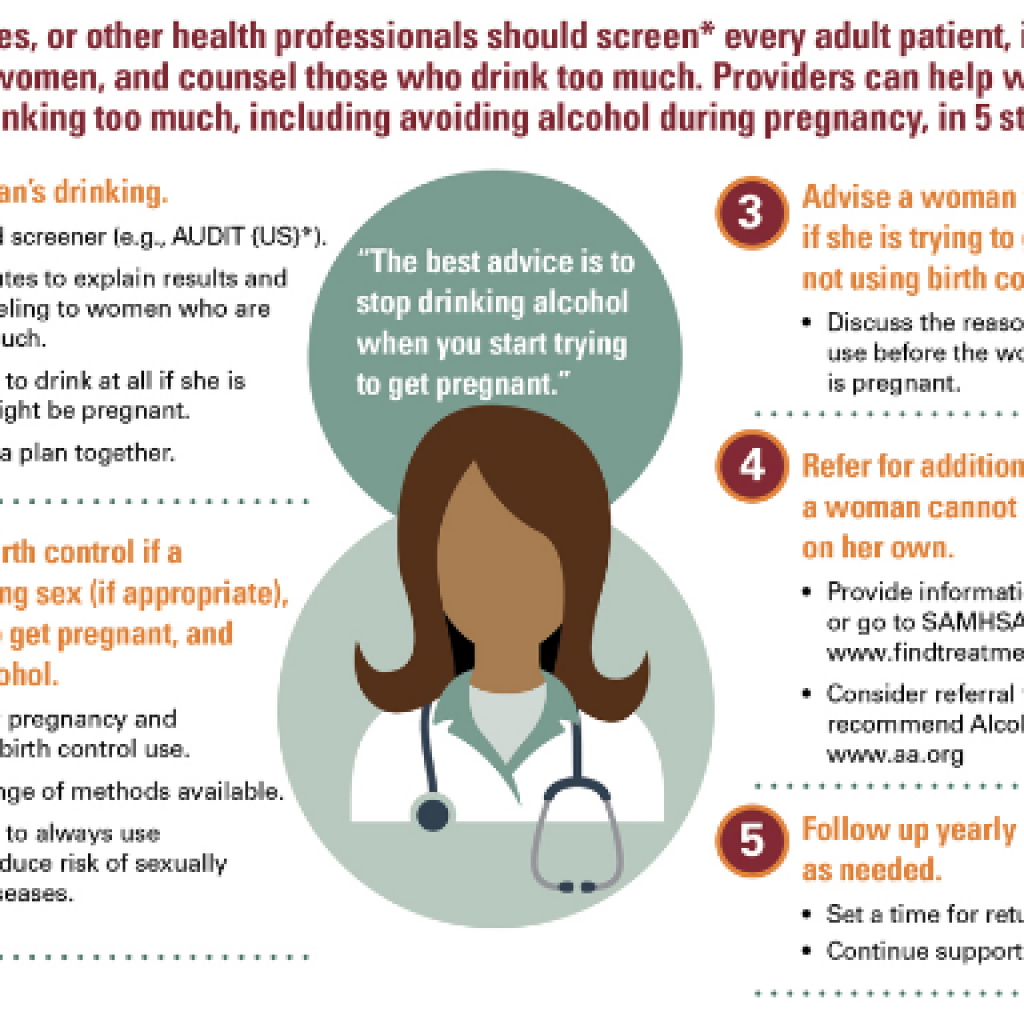
 If you don’t, you increase your chance of getting pregnant.
If you don’t, you increase your chance of getting pregnant.


